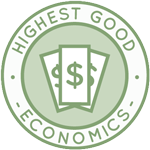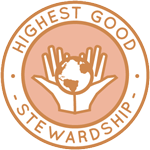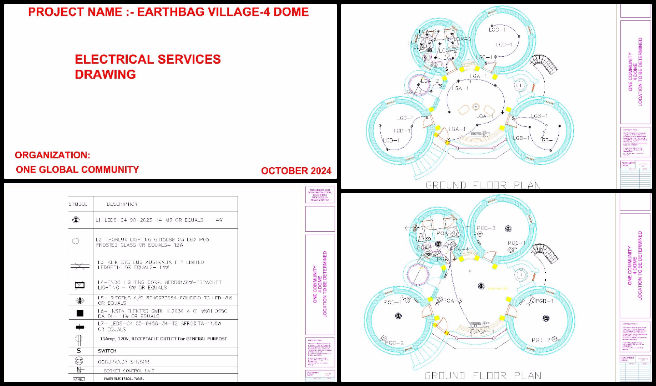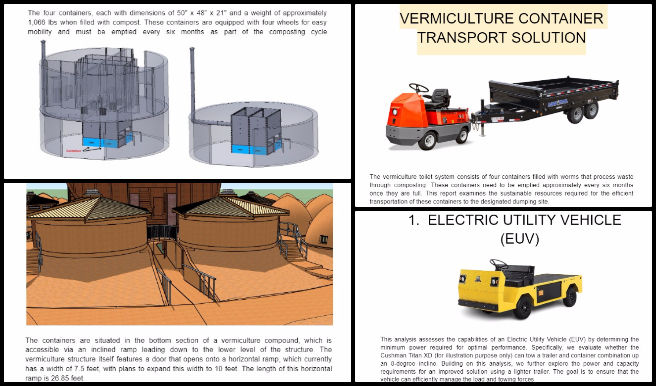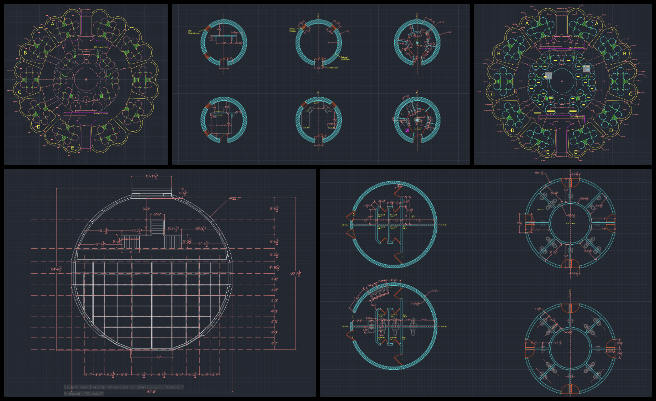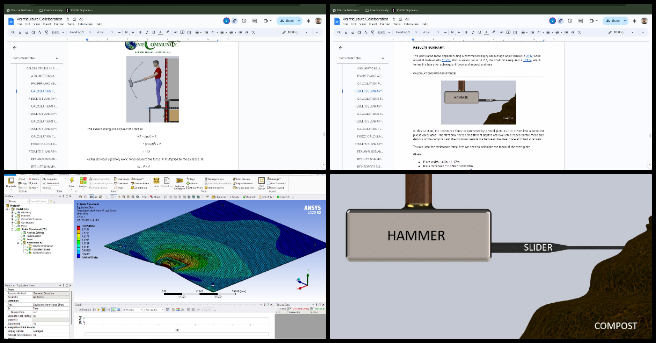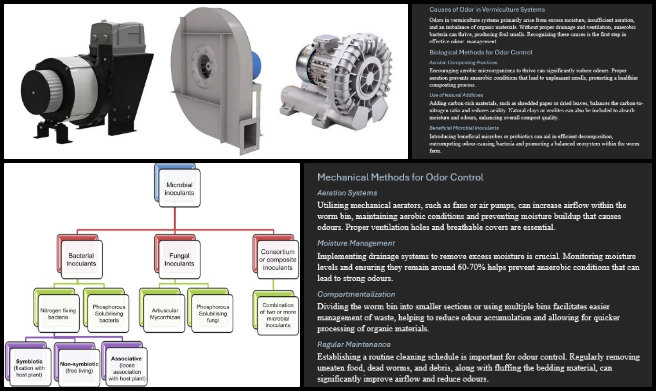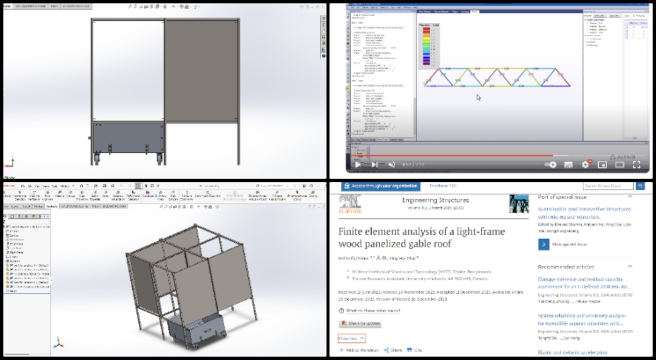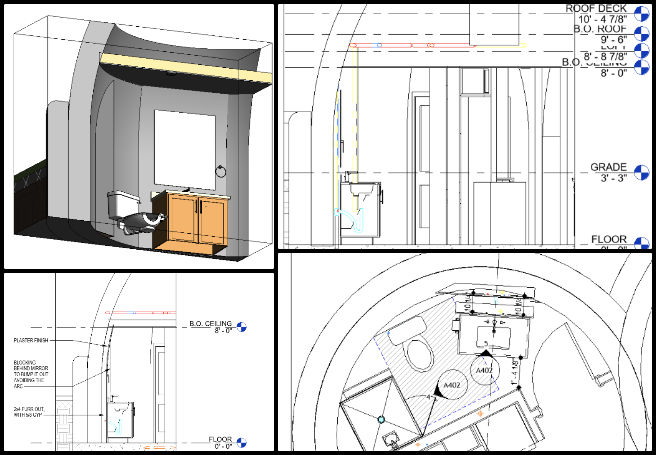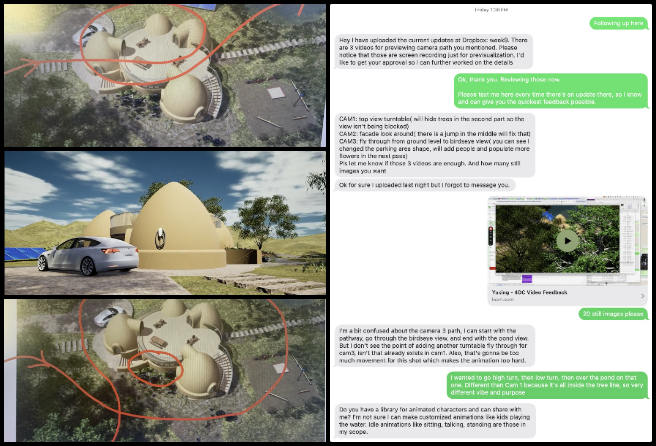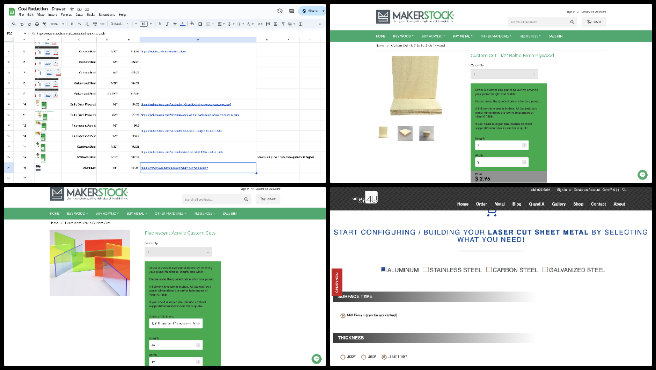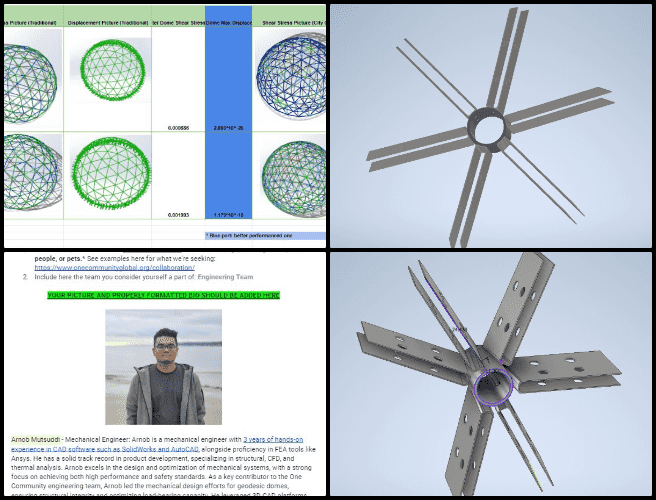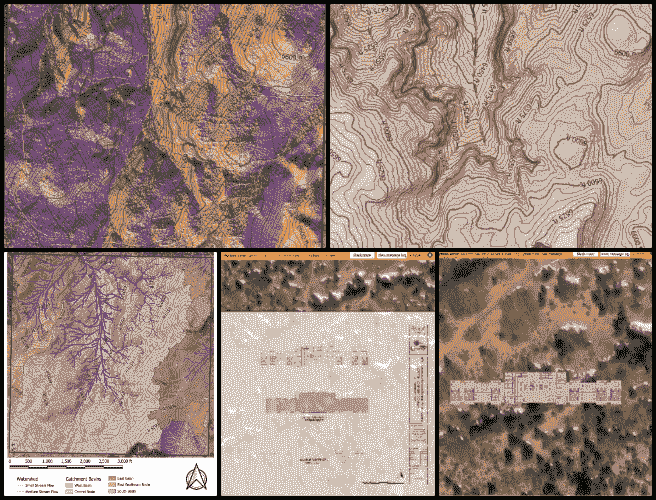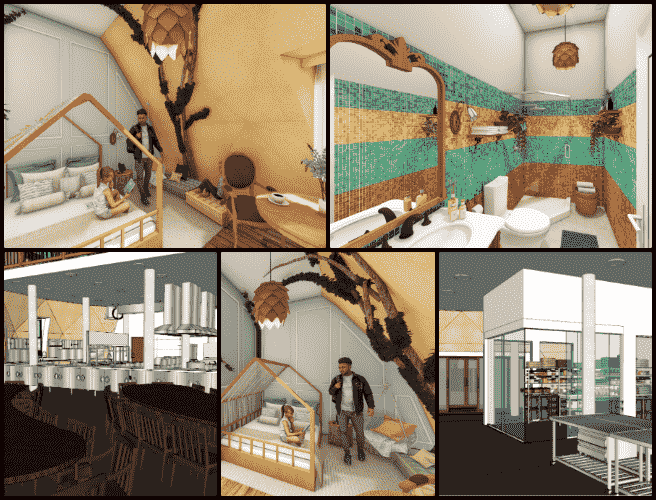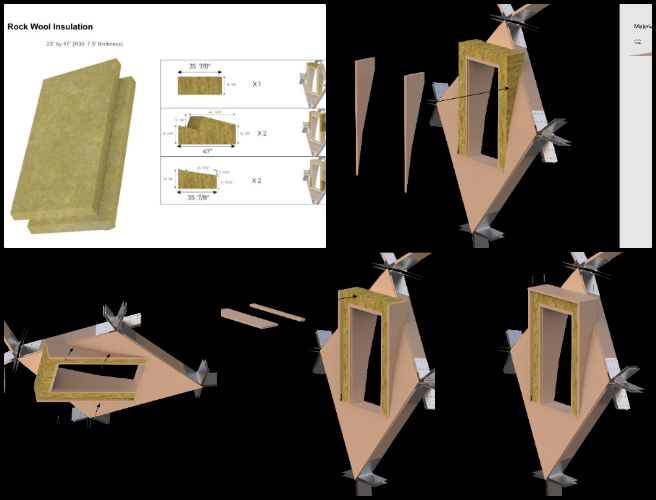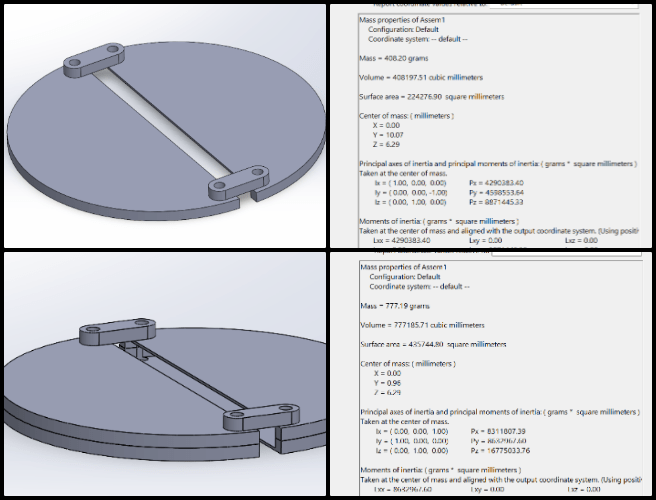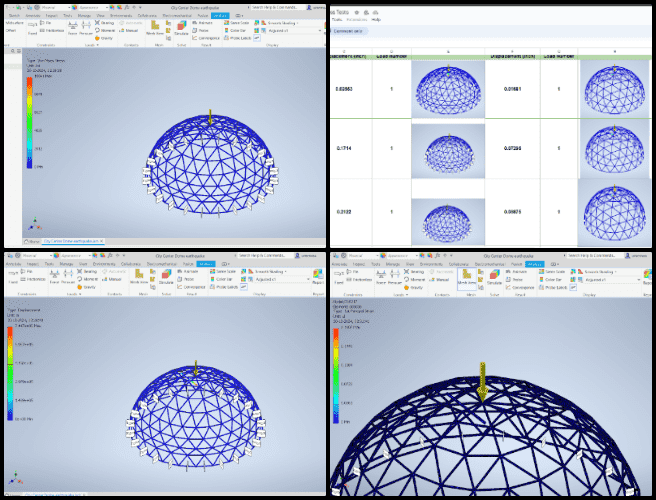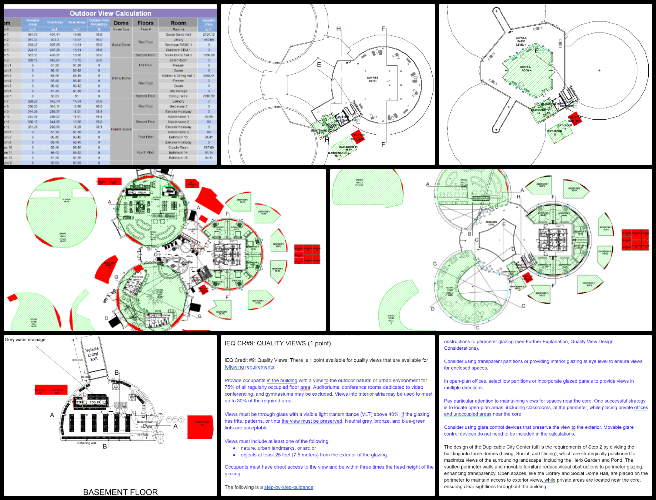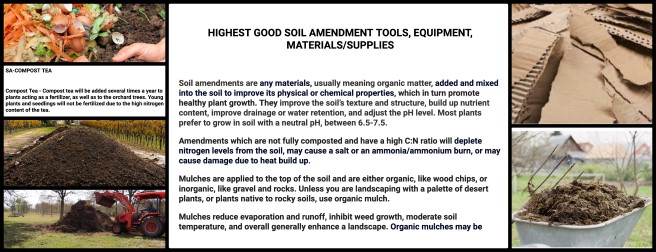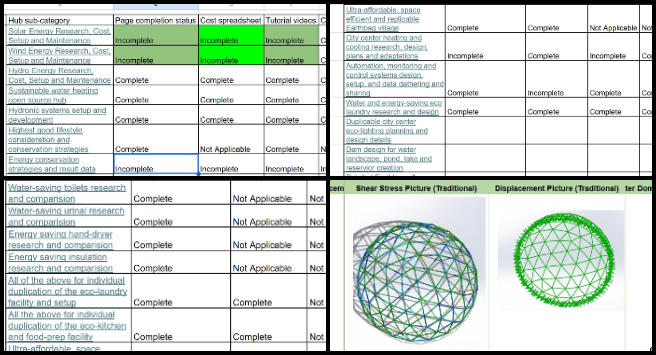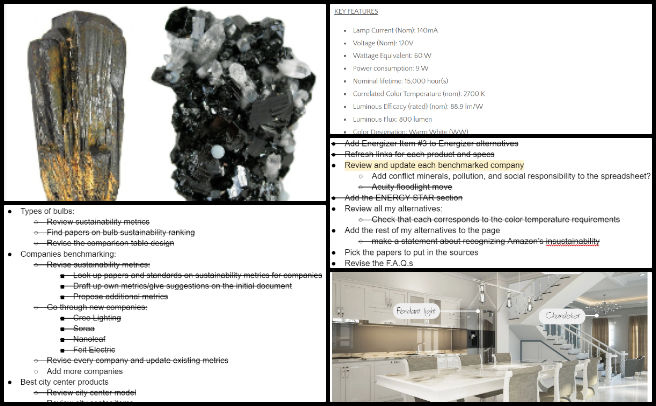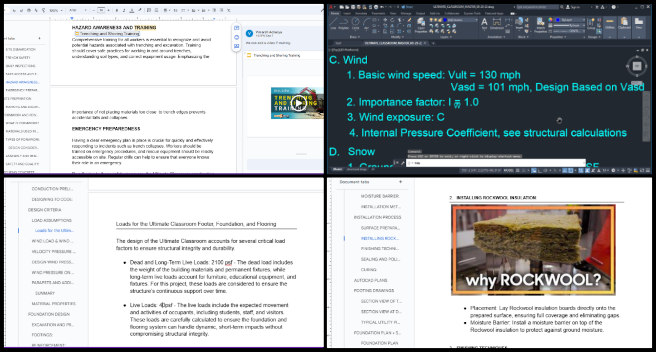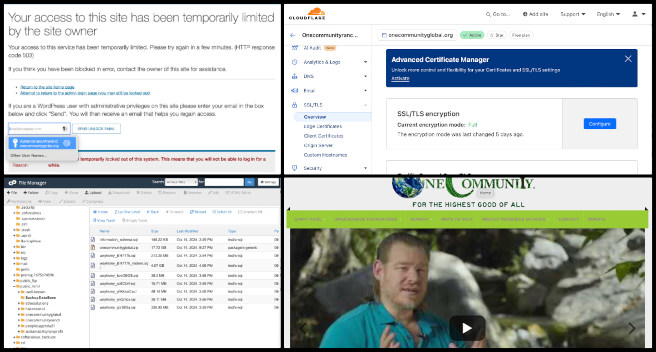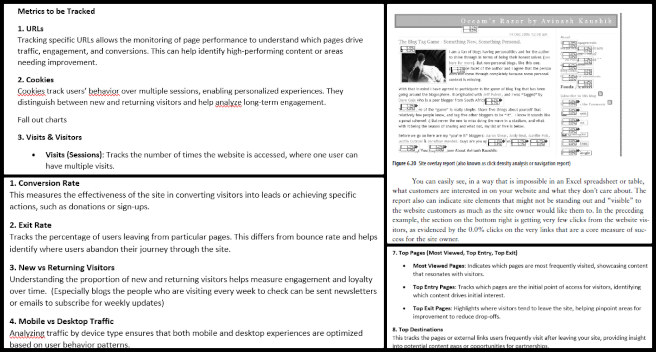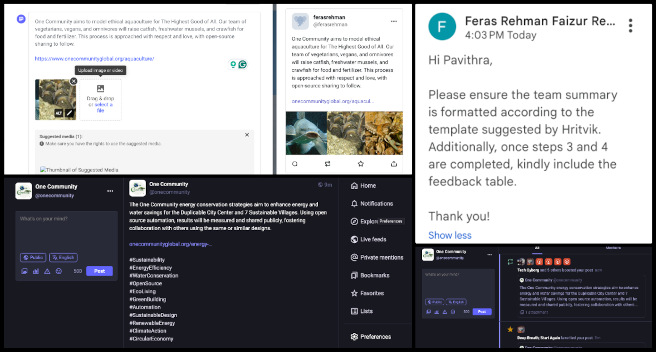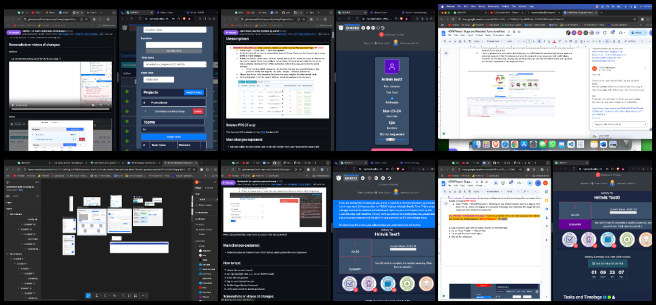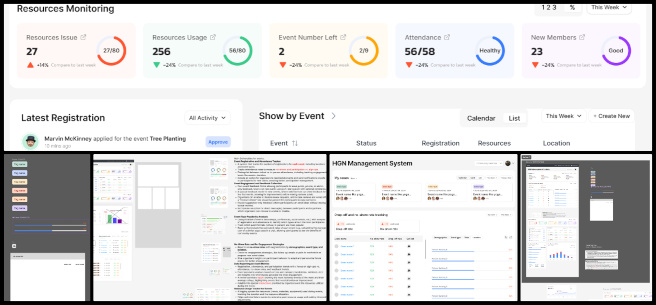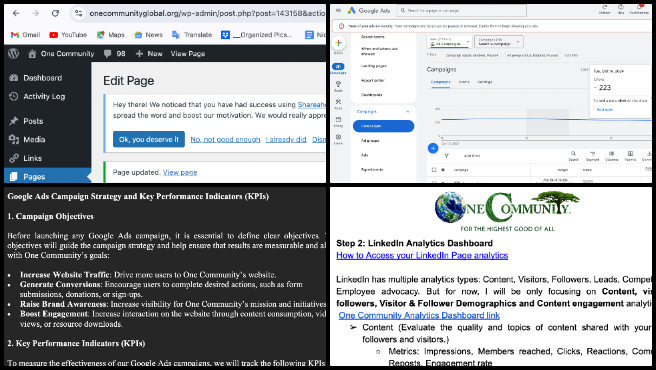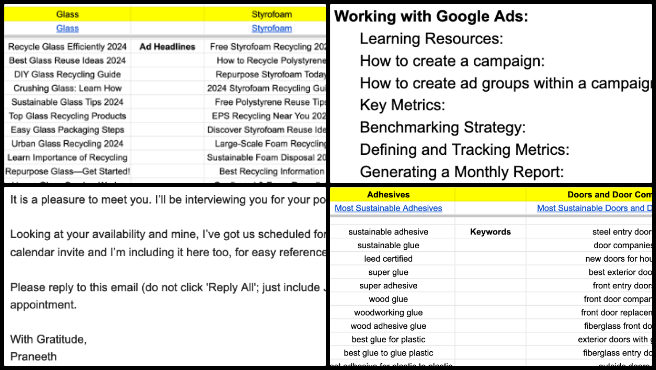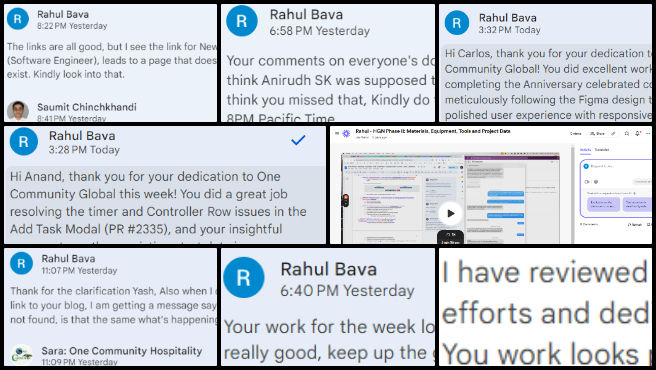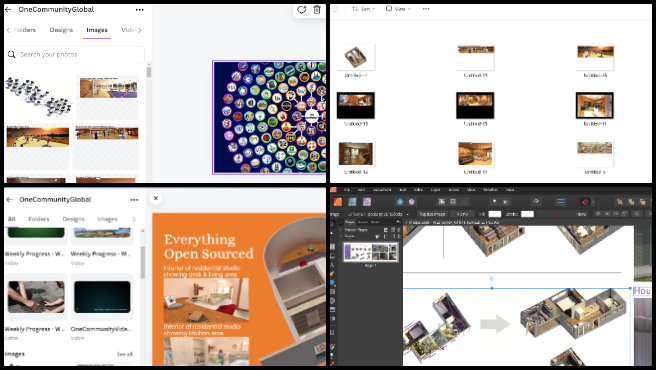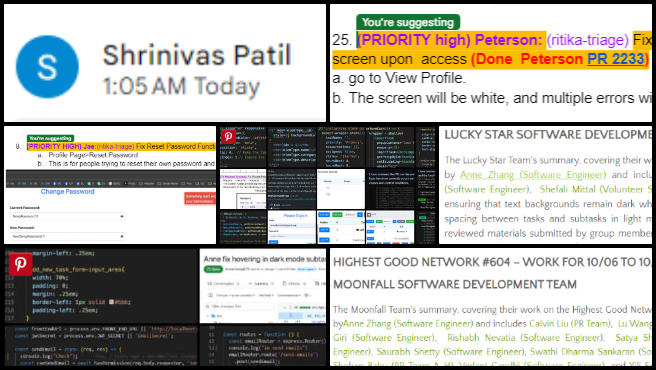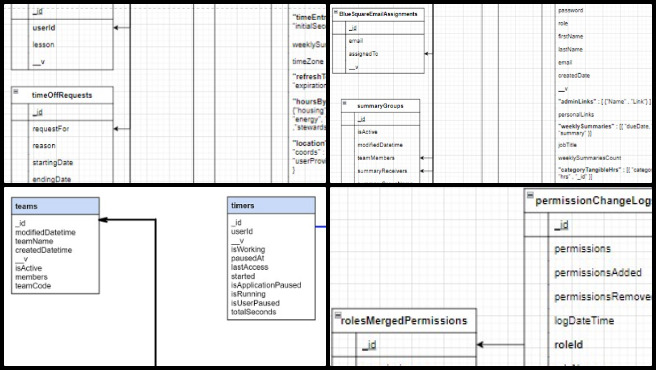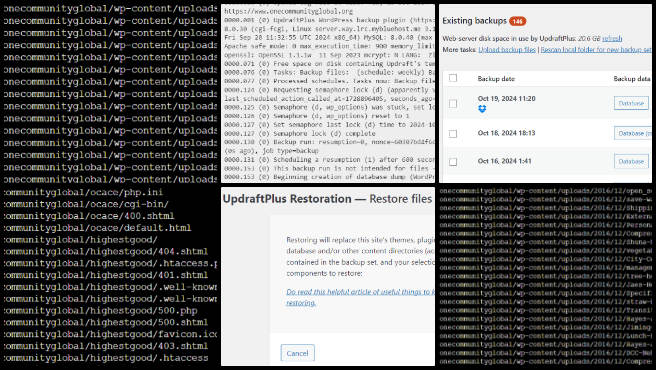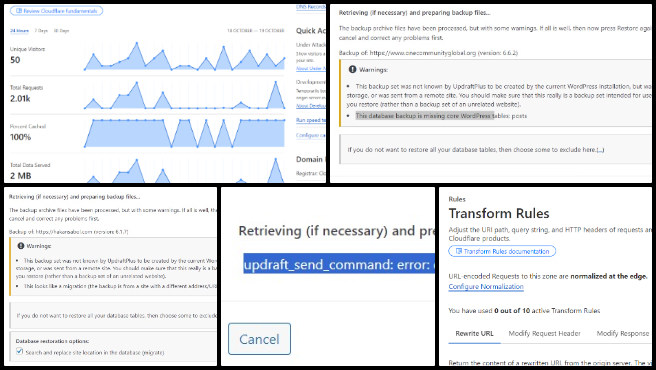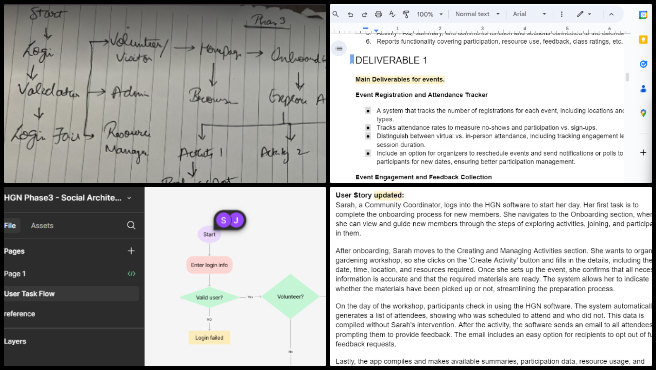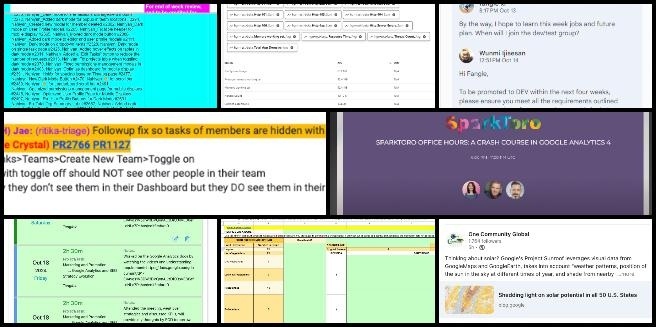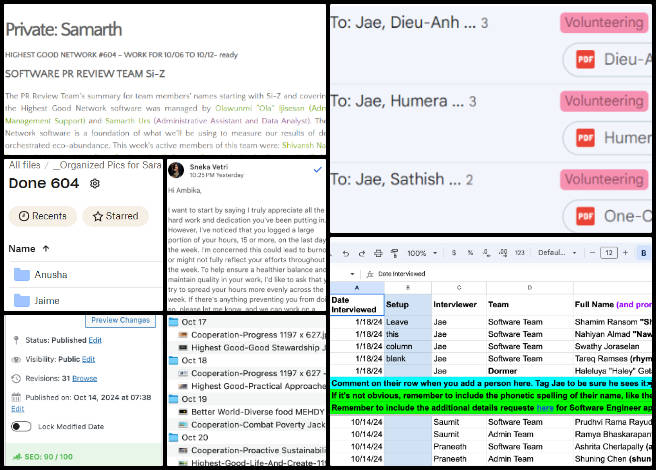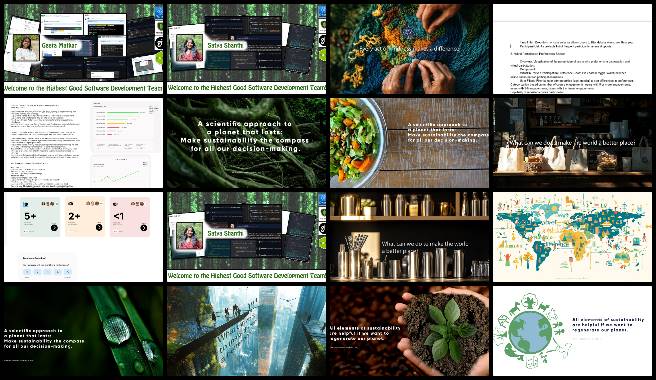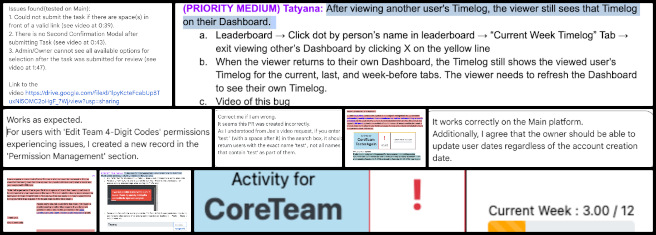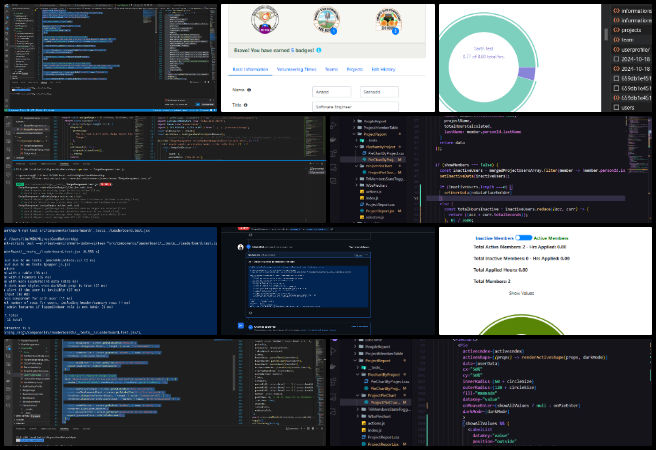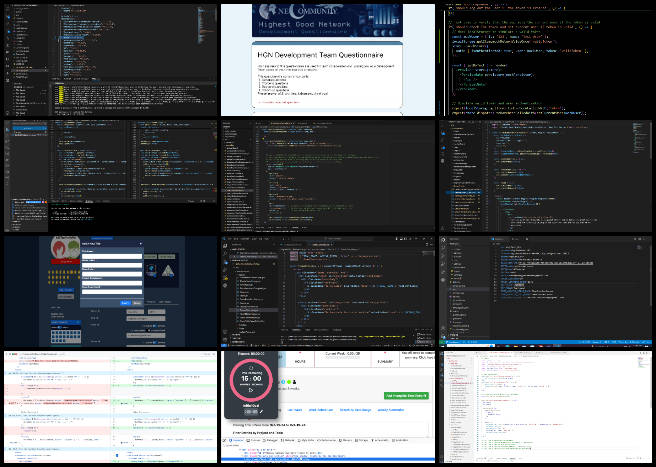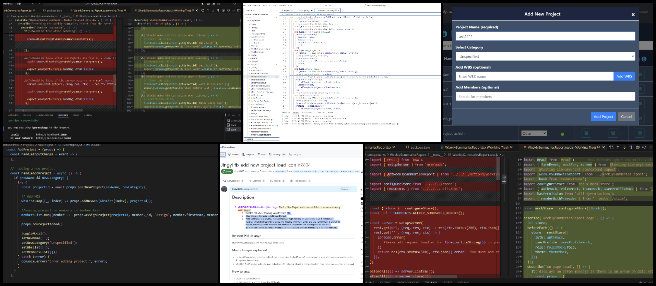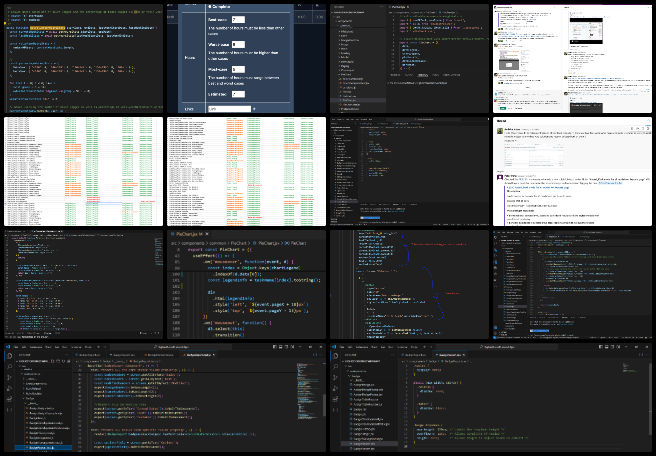Highest Good Eco-cooperative Solutions – One Community Weekly Progress Update #605
At One Community, we are developing highest good eco-cooperative solutions to regenerate our planet and create a world that works for everyone. Our all-volunteer team is focused on sustainable approaches to food, energy, housing, education, economics, and social architecture. By open sourcing and free sharing the complete process, we aim to build a self-replicating model that inspires a global collaboration of teacher/demonstration hubs, all for “The Highest Good of All.” Together, we are evolving sustainability and fostering global stewardship practices that promote fulfilled living and lasting positive change.
- Here’s our project overview
- Here’s our world-change methodology
- Here’s how this becomes self-replicating
- Here’s how we are open source and free-sharing all the do-it-yourself designs
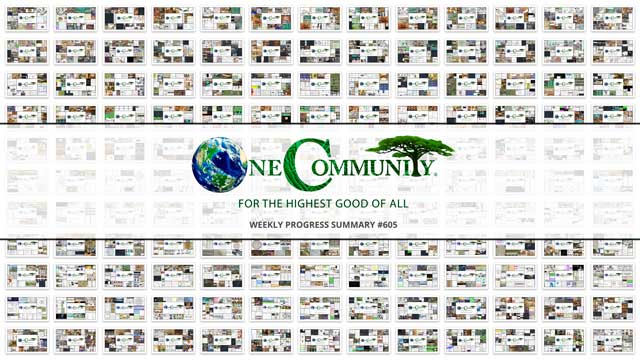
OUR MAIN OPEN SOURCE HUBS
Click on each icon to be taken to the corresponding Highest Good hub page.
One Community’s physical location will forward this movement as the first of many self-replicating teacher/demonstration communities, villages, and cities to be built around the world. This is the October 21st, 2024 edition (#605) of our weekly progress update detailing our team’s development and accomplishments:
Highest Good Eco-cooperative Solutions
One Community Progress Update #605
DONATE | COLLABORATE | HELP WITH LARGE-SCALE FUNDING
CLICK HERE IF YOU’D LIKE TO RECEIVE AN EMAIL EACH WEEK WHEN WE RELEASE A NEW UPDATE
YOU CAN ALSO JOIN US THROUGH SOCIAL MEDIA
ONE COMMUNITY WEEKLY UPDATE DETAILS
HIGHEST GOOD HOUSING PROGRESS
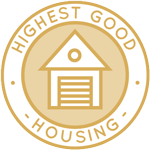 One Community is developing highest good eco-cooperative solutions through Highest Good housing that is artistic and beautiful, more affordable, more space efficient, lasts longer, DIY buildable, and constructed with healthy and sustainable materials:
One Community is developing highest good eco-cooperative solutions through Highest Good housing that is artistic and beautiful, more affordable, more space efficient, lasts longer, DIY buildable, and constructed with healthy and sustainable materials:
- Learn about highest good eco-cooperative solutions: Our Upcoming Crowdfunding Campaign
- Learn about the different village models: 7 Sustainable Village Models
- Visit the open source portals for the first two: Earthbag Village OS Hub | Straw Bale Village OS Hub
This week, Adefola (Fola) Madehin (Electrical Design Specialist) continued his work with Earthbag Village electrical designs. Fola completed the lighting, socket, and panel layout for the Earthbag Village 4 dome project. Receptacles were placed in the bedrooms and living room, with the distribution panel installed in the living room and additional receptacles positioned in the dome rooms. All designs adhered to the American standard for single-phase voltage at 120 volts. The Earthbag Village is the first of 7 to be built as the housing component of One Community’s open source model for developing highest good eco-cooperative solutions. See some of his work in the collage below.
Adil Zulfiquar (Engineer) continued working on the Vermiculture Toilet designs. He focused on finalizing the report on the vermiculture container transport solution. Feedback from the initial report was reviewed, and additional sketches and images were incorporated to better explain the overall requirements and proposed solutions for transportation. Extra context was added to each segment of the report, along with references. The final Excel tables were created to support the content, and backups were prepared to ensure all data was securely stored. The Earthbag Village is the first of 7 to be built as the housing component of One Community’s open source model for developing highest good eco-cooperative solutions. See below for some of the pictures related to this work.
Akshit Sethi (Architectural Designer) continued working on finalizing the interior of the Earthbag Village 4-dome home design. Akshit worked on the EarthBag Village project, focusing on finalizing all plans. This included updating the internal and external clusters, refining room layouts, and revising the master plan to ensure accuracy and cohesion across the project. These updates contribute to a more comprehensive and coordinated design for the village. The Earthbag village is the first of 7 villages to be built as part of One Community’s open source model for developing highest good eco-cooperative solutions. See his work in the collage below.
Anil Karathra (Mechanical Engineer) continued working on the Vermiculture Toilet designs. He focused on team management and documentation tasks, including refining engineering documents based on feedback and making updates. Visuals and animations were created to support the vermiculture toilet project. The CAD model of the slider was edited, a new finite element analysis (FEA) was performed, and the results were incorporated into the document. Research was also conducted on the environmental impacts of materials used for the vermiculture toilets, with findings documented. In addition, Anil focused on compiling weekly summaries, generating pictures, and preparing a bio for website publication. The approach for developing highest good eco-cooperative solutions enables the development of innovative solutions that are both environmentally friendly and effective. See below for some of the pictures related to this work.
Joseph Osayande (Mechanical Engineer) continued helping finish the Vermiculture Toilet engineering and design details. Joseph researched methods for controlling odors in vermiculture systems, exploring both biological and mechanical options. A short report summarizing these odor control methods was prepared. Additionally, research on pest management strategies for vermiculture systems was initiated, with ideas being formulated on how these strategies could be integrated into the current vermiculture build. The Earthbag Village is the first of 7 to be built as the housing component of One Community’s open source model for developing highest good eco-cooperative solutions. See some of his work in the collage below.
Karthik Pillai (Mechanical Engineer) continued helping finish the Vermiculture Toilet engineering and design details. Karthik focused on refining the Unistrut assembly by integrating the drawer and side panels and making structural modifications based on feedback from the weekly meeting. He redesigned the waste dumping assembly, incorporating a sign post and a newalpopin and rocker mechanism to enhance structural stability, followed by performing finite element analysis (FEA) to ensure the system’s performance under load. Additionally, in the four-dome cluster project, Karthik worked on analyzing the roof joist using software tools and aimed to assist his teammates with the FEA of the roof joist. The Earthbag Village is the first of 7 to be built as the housing component of One Community’s open source model for developing highest good eco-cooperative solutions. See some of his work in the collage below.
Michaela Silva (Architect) continued working on finalizing the interior of the Earthbag Village 4-dome home design. Michaela linked the MEP Revit model to the main 4-dome model, enabling a 3D comparison of layouts to identify any potential conflicts. The team decided to use Pex pipes due to their flexibility in accommodating the dome’s curves. Following this decision, she updated the Revit model to reflect the necessary cavity design for the plumbing pipes. The Earthbag village is the first of 7 villages to be built as part of One Community’s open source model for developing highest good eco-cooperative solutions. See her work in the collage below.
Yuxing Xu (VFX Artist) continued working on making videos for the Earthbag Village 4-dome home design. Yuxing worked on finalizing the flyover videos for the scene, making adjustments to the parking area, foliage, flowers, and cameras for three videos. He discussed the video with Jae and made improvements to the camera path based on their conversation. Additionally, he focused on finalizing the character and textures, ensuring the delivery of both videos and images. The Earthbag Village is the first of 7 to be built as the housing component of One Community’s open source model for developing highest good eco-cooperative solutions. See some of his work in the collage below.
Yuze Tang (Architect) continued working on Vermiculture Toilet designs. He spent time researching alternative materials for a drawer project, examining the prices and properties of various materials, including aluminum, stainless steel, carbon steel, galvanized steel, Baltic birch plywood, and fluorescent acrylic. Due to the varying strengths of these materials, he adjusted the thickness specifications and revisited the material pricing accordingly. The approach of developing highest good eco-cooperative solutions enables the development of innovative solutions that are both environmentally friendly and effective. See below for some of the pictures related to this work.
DUPLICABLE CITY CENTER PROGRESS
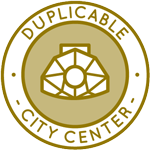 One Community is developing highest good eco-cooperative solutions through a Duplicable and Sustainable City Center that is LEED Platinum certified/Sustainable, can feed 200 people at a time, provide laundry for over 300 people, is beautiful, spacious, and saves resources, money, and space:
One Community is developing highest good eco-cooperative solutions through a Duplicable and Sustainable City Center that is LEED Platinum certified/Sustainable, can feed 200 people at a time, provide laundry for over 300 people, is beautiful, spacious, and saves resources, money, and space:
- Learn about this building and it’s function in highest good eco-cooperative solutions: Duplicable City Center Open Source Hub
Arnob Mutsuddi (Mechanical Engineer) continued working on Duplicable City Center structural engineering model and details. He calculated the measurements to update the report for the Traditional vs. Stress test, and the wind load analysis report for the same test was revised with the latest results. A bio was provided for inclusion on the collaborators page, and editing began on the U hub connector. Work continued on modifying the hub connector for row 2 of the geodesic dome. A team meeting was held to discuss work progress, and insights were shared on simulation result data provided by teammates. The Duplicable City Center is a foundational part of One Community’s open-source model, which excels in becoming the developing highest good eco-cooperative solutions. This approach is integral to their mission of developing highest good eco-cooperative solutions through innovative and scalable solutions. See some of this work in the pictures below.
Chris Blair (GIS Technician/Horticulturist) continued working with GIS data as part of One Community’s Permaculture Design that includes the location of the Duplicable City Center. He continued learning how to use QGIS, an open-source GIS software, with the goal of recreating his previous work from proprietary software to improve future access to the data. He created maps displaying watershed basins, water flow, slope, solar aspect, and solar potential of the property. Chris also began re-digitizing the villages and community center based on updated area measurements of their footprints. Within One Community’s open-source framework, the Duplicable City Center plays a central role in developing highest good eco-cooperative solutions. The images below showcase some of this work.
Faeq Abu Alia (Architectural Engineer) continued his work on the Duplicable City Center kitchen shelving and adding dry-storage food items. He worked on preparing the City Center kitchen in SketchUp for the walkthrough video. He also focused on the walkthrough video for Room 12, utilizing SketchUp for modeling and Lumion for rendering, ensuring accurate representations and realistic visuals to effectively showcase the overall design and functionality of both spaces. The Duplicable City Center represents a fundamental element of One Community’s open-source approach, dedicated to developing highest good eco-cooperative solutions. View examples of this work in the pictures provided below.
Nika Gavran (Industrial Designer) continued her work on the Duplicable City Center dormer window installation plans. She focused on expanding the final document for the dormer window instructions, with particular attention to incorporating rock wool insulation. She removed shadows from the images, rerendered them, and arranged everything into a more appealing layout. Preview images showing the placement of insulation were added to the materials list, positioned next to the insulation dimensions for clarity. Nika also worked on compiling all the slides to ensure the instructions are clear and organized. As a foundational component of One Community’s open-source strategy, the Duplicable City Center is designed for developing highest good eco-cooperative solutions. The images below showcase some of this work.
Sanket Basannavar (Mechanical Engineer) continued his research on the structure and materials used in spa covers currently available in the market. He explored designs for spa covers and cover handlers, including a modular panel design with unistruts, a folding cover with hydraulic lifters, a sliding cover with a track system, and an aluminum frame cover with lift-assist hinges. Sanket also proposed a bi-fold cover with hydraulic lift assist and a smart cover with an integrated solar panel option. Additionally, he studied the use of hydraulic lifters in spa covers and performed finite element analysis (FEA) on existing spa cover lifters in the market. He designed a basic foldable cover focusing on the top half and evaluated its weight and mass properties. Within One Community’s open-source framework, the Duplicable City Center plays a central role in developing highest good eco-cooperative solutions. The images below showcase some of this work.
Tasmia Hasan (Design Engineer) continued her work on the structural engineering of the Duplicable City Center. She completed a seismic analysis. Initially, she attempted to perform the analysis using SolidWorks but encountered challenges. After further research, she determined that Autodesk Robot is more commonly used for this type of work. Using U.S. building codes, Tasmia calculated displacement values under specific loads to simulate earthquake conditions and obtained results within the Autodesk Robot application. As a foundational component of One Community’s open-source strategy, the Duplicable City Center is designed for developing highest good eco-cooperative solutions. You can see examples of this work in the following images.
Umema Ali (Mechanical Design Engineer) continued working on the Duplicable City Center Engineering. She updated the spreadsheet with the results of the vertical load static structural analysis completed using Inventor. Work also began on the static structural analysis for snow loads, focusing on the new dome structure and the traditional structure. Inventor was utilized to assess performance under these specific load conditions. Within One Community’s open-source framework, the Duplicable City Center plays a central role in developing highest good eco-cooperative solutions. The images below showcase some of this work.
Yancong E (Architectural Designer) continued working on the Duplicable City Center project. He fixed problems in the AutoCAD file, recalculated the visible and dead areas for certain rooms, and adjusted the corresponding data and formatting in the spreadsheet based on Jae’s feedback. He also reviewed the USGBC’s requirements for Quality Views points and step-by-step guidance and started working on the final report. The Duplicable City Center represents a fundamental element of One Community’s open-source approach, dedicated to developing highest good eco-cooperative solutions. This innovative initiative aims to showcase how developing highest good eco-cooperative solutions can transform urban spaces into more sustainable and community-oriented environments. You can see examples of this work in the following images.
HIGHEST GOOD FOOD PROGRESS
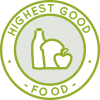 One Community is developing highest good eco-cooperative solutions throug Highest Good food that is more diverse, more nutritious, locally grown and sustainable, and part of our open source botanical garden model to support and share bio-diversity:
One Community is developing highest good eco-cooperative solutions throug Highest Good food that is more diverse, more nutritious, locally grown and sustainable, and part of our open source botanical garden model to support and share bio-diversity:
- Learn about the structures: Hoop House Hub | Aquapini & Walipini Open Source Hub
- See what we’ll be growing and developing highest good eco-cooperative solutions: Gardens & Hoop Houses | Large-scale Structures | Food Forest | TA
This week, the core team continued their research for the Highest Good Soil Amendment Tools, Equipment, Materials/Supplies list. They supplemented the existing descriptions of soil amendments and added corresponding photos. These updates included comfrey, chicken manure, food scraps, compost, and leaves. The Highest Good Food initiative is a key component of One Community’s open source plans, dedicated to developing highest good eco-cooperative solutions. See their work in the collage below.
Jay Nair (BIM Designer) continued working on Aquapini and Walipini Planting and Harvesting lighting and HVAC design. He focused on researching the climate battery system and exploring its integration into greenhouse designs. The research covered the principles of thermal mass storage and how the climate battery utilizes underground pipes to store daytime heat for release during cooler periods, optimizing energy efficiency. Jay examined the ideal configurations, such as trench depth, pipe layout, and air circulation mechanisms, assessing their feasibility for the specific greenhouse footprint. Challenges like condensation management, potential blockages, and the effectiveness of insulation layers around the trench were studied, with strategies proposed for mitigation. Additionally, Jay investigated the incorporation of passive ventilation systems to enhance the climate battery’s functionality, maintaining stable temperatures and humidity levels throughout the year. The Highest Good Food initiative is a key component of One Community’s open source plans, dedicated to developing highest good eco-cooperative solutions, and exemplifies the organization’s commitment to developing highest good eco-cooperative solutions through innovative design and implementation. Below are some of the images showcasing this work.
Purva Borkar (Landscape Architect) started her work on creating an an outdoor blend of a food-producing ecosystem and people-friendly spaces for the Aquapini and Walipini Planting and Harvesting structures. A detailed study was conducted on sustainable gardening and water management systems, emphasizing food forests and public space design. The research covered the layering of plants in food forests to enhance biodiversity and productivity. Additionally, strategies for rainwater catchment, swales, and pond systems were explored for efficient water management. Public space design elements, such as community gathering areas, walking trails, bioswales, and green roofs, were reviewed. The study also included case studies focused on enhancing urban spaces with sustainable, interactive features. As part of One Community’s open source efforts, the Highest Good Food initiative embodies a commitment to developing highest good eco-cooperative solutions. The images below offer a glimpse into these ongoing efforts.
Syahrina Maulida Majid (Volunteer Nutritionist) continued working on creating menu implementation tutorials as a part of One Community’s Transition Food Self-Sufficiency Plan. She focused on refining the “Recipe Build Out Tool Home Page Mockups” and documenting corrections for the food self-sufficiency transition plan. She ensured the accuracy of all food resources listed and communicated updates with the team through Google Docs. Additionally, she worked on reviewing and testing the master menu template to create a user-friendly and adaptable tutorial for various dietary needs. In this process, she identified gaps, made updates, and simplified the tutorial for easier implementation. Syahrina also had a discussion with Jessica regarding the tutorial-building process, communicated any issues found, and ensured that all resources were backed up for future use. The Highest Good Food initiative plays a crucial role in One Community’s open source plans, with the aim of developing highest good eco-cooperative solutions. Her work is showcased in the collage below.
Xuanjun Liu (Landscape Designer) continued working on the Cloud Forest House Zenapini renderings in Lumion. The tasks involved refining material details by adjusting plant materials, structural materials, ground cover, and various shapes and forms to create a more natural appearance consistent with the look of a cloud forest. Lighting materials were added to the site to enhance the overall atmosphere and integrate with the natural elements of the design. Fog effects were also experimented with to simulate the intended cloud forest atmosphere. Highest Good Food is key to developing Highest Good eco-cooperative solutions within One Community’s open source plans. See some of this work in the pictures below.
Ziyi Chen (Landscape Designer) continued working on the design of the outdoor spaces for the Aquapini and Walipini Planting and Harvesting structures. She focused on completing detailed CAD drawings and finalizing tree species. Careful planning and technical accuracy are required to ensure the design elements meet project specifications. Building on a previously selected list, Ziyi narrowed down plant species with an emphasis on low-maintenance options to support sustainability. The selected tree species were incorporated into the design plan, and preparations were made for marking them to align with the project’s sustainability objectives. The Highest Good Food initiative is a key component of One Community’s open source plans, dedicated to developing highest good eco-cooperative solutions. See her work in the collage below.
HIGHEST GOOD ENERGY PROGRESS
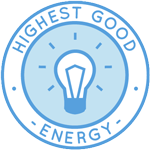 One Community is designing highest good eco-cooperative solutions through Highest Good energy that is more sustainable, resilient, supports self-sufficiency and includes solar, wind, hydro and more:
One Community is designing highest good eco-cooperative solutions through Highest Good energy that is more sustainable, resilient, supports self-sufficiency and includes solar, wind, hydro and more:
- Learn about the open source sustainable-energy foundations: Solar, Hydro, and Wind
- Explore our research into the most sustainable products and companies for saving water and energy: Insulation, Eco-laundry, Lightbulbs and Light Bulb Companies, Doors and Door Companies, Windows and Window Companies, Toilets, Faucets and Faucet Accessories, Urinals, and more.
This week, Panambur Rachan Rao (Project Manager) continued managing the Highest Good energy work-remaining analysis and managing the City Center hub connector team. He revised the DCC dome structure stress test spreadsheet with the latest values. He also collaborated with the analysis team on their updates and upcoming tasks. Additionally, Rachan updated the Highest Good Energy spreadsheet based on the feedback received, including color-coding tasks that he can handle and those that should be assigned to a specialist. Within One Community’s open-source framework, the Duplicable City Center plays a central role in developing highest good eco-cooperative solutions. Take a look at some of this work in the images below.
Viktoriia Zakharova (Administrative Assistant) worked on finalizing the sustainable light bulb alternatives web guide, updating product pages, specification sheet links, and replacing outdated listings with new ones. Viktoriia also researched the presence of conflict minerals in the lighting industry. Additionally, she handled administrative tasks by reviewing and publishing the work of the Highest Good food team. The Duplicable City Center represents a fundamental element of One Community’s open-source approach, dedicated to developing highest good eco-cooperative solutions. View examples of this work in the pictures provided below.
HIGHEST GOOD EDUCATION PROGRESS
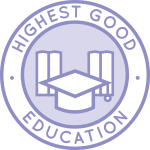 One Community is developing highest good eco-cooperative solutions through Highest Good education that is for all ages, applicable in any environment, adaptable to individual needs, far exceeds traditional education standards, and more fun for both the teachers and the students. This component of One Community is about 95% complete with only the Open Source School Licensing and Ultimate Classroom construction and assembly details remaining to be finished. With over 8 years of work invested in the process, the sections below are all complete until we move onto the property and continue the development and open sourcing process with teachers and students – a development process that is built directly into the structure of the education program and everything else we’re creating too:
One Community is developing highest good eco-cooperative solutions through Highest Good education that is for all ages, applicable in any environment, adaptable to individual needs, far exceeds traditional education standards, and more fun for both the teachers and the students. This component of One Community is about 95% complete with only the Open Source School Licensing and Ultimate Classroom construction and assembly details remaining to be finished. With over 8 years of work invested in the process, the sections below are all complete until we move onto the property and continue the development and open sourcing process with teachers and students – a development process that is built directly into the structure of the education program and everything else we’re creating too:
- Program Overview: Education Open Source Hub
- How the components work together in developing highest good eco-cooperative solutions: How to use the Education for Life Program
- Lesson Plans for Life – Lesson Plans How-to
- Foundations of Outstanding Leaders, Teachers, and Communicators
- Curriculum for Life
- Teaching Strategies for Life
- Learning Tools and Toys for Life
- Evaluation and Evolution
This week, Brian Mwoyowatidi (Graduate Structural Engineer) continued helping with the engineering details for the Ultimate Classroom part of the Highest Good education component. Brian continued working on the Engineering Report and Tutorial for the Ultimate Classroom, adding the load factors considered for the footer, foundation, and flooring of the Ultimate Classroom. He has added the dead loads, long-term live loads, and live loads. He also included a 21-minute training video for Trench and Excavation Safety. The One Community model of combining forward-thinking education with sustainably built classrooms like this is an excellent example of developing highest good eco-cooperative solutions. This approach exemplifies developing highest good eco-cooperative solutions by creating environments fostering collaboration and innovation. See the collage below for his work.
HIGHEST GOOD SOCIETY PROGRESS
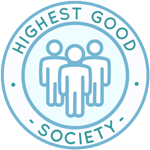 One Community is developing highest good eco-cooperative solutions through a Highest Good society approach to living that is founded on fulfilled living, the study of meeting human needs, Community, and making a difference in the world:
One Community is developing highest good eco-cooperative solutions through a Highest Good society approach to living that is founded on fulfilled living, the study of meeting human needs, Community, and making a difference in the world:
- Read the Highest Good society overview: Highest Good Society
- Learn about the model for fulfilled living and sharing: A Day in the Life
- Learn about the 4 economic models: RBE | For-profit | Non-profit | Entrepreneurship
- Learn about our open source community collaboration and management software: The Highest Good Network
This week, the core team completed over 67 hours managing One Community’s volunteer-work review not included above, emails, social media accounts, web development, new bug identification and bug-fix integration for the Highest Good Network software, and interviewing and getting set up new volunteer team members. They also shot and incorporated the video above, that talks about developing highest good eco-cooperative solutions and how developing highest good eco-cooperative solutions is a foundation of the bigger picture of everything One Community is doing. The image below shows some of this work.
Aravind Yuvraj focused on addressing issues related to a website crash that resulted in losing the latest file. Efforts were made to restore the site, but the latest file could not be recovered. Coordination with the Bluehost support team was necessary to resolve the issue, and backups of the site’s files were saved using the File Manager. The site was eventually restored with the assistance of Bluehost, although there were ongoing challenges in fixing the underlying problem that caused the site to go down. This work helps One Community’s mission of developing highest good eco-cooperative solutions and reinforces our commitment to developing highest good eco-cooperative solutions. The following images show his work for the week.
Deepthi Arcot Subramanyam (Data Analyst) focused on developing the strategy for the Google Analytics team, identifying key performance indicators (KPIs) that could be utilized across all pages. She analyzed the top pages requiring tracking and held a meeting with the Google Analytics team to discuss their perspectives on the strategy. Deepthi connected with Riddhisha to plan the next steps for submitting the strategy and gathered input from Jae regarding mission-specific KPIs. Additionally, she worked on summarizing the Skye Team’s activities, organizing folders, and creating a collage. This work helps One Community’s mission of developing highest good eco-cooperative solutions and reinforces our commitment to developing highest good eco-cooperative solutions. The following images show her work for the week.
Feras Rehman (Data Analyst) continued working on developing One Community’s Mastodon account and strategy. He also managed his part of the One Community Updates Blog where he reworked the blog code #604 and provided feedback to Pavithra Doraiswamy. Additionally, six Mastodon posts were scheduled on Buffer for the upcoming week. Targeted strategies for Mastodon were developed and implemented, leading to a fourfold increase in post reach through the use of optimized hashtags and improved post structuring. Images were added to supplement a summary, enhancing its content and clarity. This work helps One Community’s mission of developing highest good eco-cooperative solutions and reinforces our commitment to developing highest good eco-cooperative solutions. The following images show his work for the week.
Gavin Burke worked with the tech team to address routine outages of the One Community Website. He had a meeting with Jaya and Aravind to establish priorities and set up a group chat with the entire team to improve communication. Gavin welcomed new team members, Namra and Vishnu, assigned them tasks, and provided support to help them get started. Additionally, he researched potential solutions for improving the website’s stability, including the option of switching to a different hosting provider and identifying issues that could impact performance. This work helps One Community’s mission of developing highest good eco-cooperative solutions and reinforces our commitment to developing highest good eco-cooperative solutions. The following images show his work for the week.
Hritvik Mahajan (Data Analyst) worked on the social media scheduler by providing steps and suggestions as requested. Hritvik collaborated with team members, tested several pull requests (PRs) on the development site, and addressed Phase 1 bugs. He began organizing and updating a new document and the Figma page, as reviewed by Jae, using ideas from other schedulers and selecting posts for Twitter. Hritvik provided feedback on Pavithra’s and Shuning’s initial admin training, continued PR testing, and managed tags on GitHub. He also contributed to the Figma design for the social media scheduler, incorporating screenshots, posted updates across 11 Twitter communities, and started assisting with pending PRs. This work helps One Community’s mission of developing highest good eco-cooperative solutions and reinforces our commitment to developing highest good eco-cooperative solutions. The following images show his work for the week.
Jiaqi Wu (UX Designer) had a meeting with the team to align on the requirements for the first delivery, clarifying the data and cross-metric relationships that needs to be tracked. She also met with her design teammates and identified overlaps in their work. After discussing the issue with them, they decided to integrate these elements into a new version. This work helps One Community’s mission of developing highest good eco-cooperative solutions and reinforces our commitment to developing highest good eco-cooperative solutions. The following images show her work for the week.
Nidhi Mange (Data Analyst) analyzed Google Ads and developed strategies for optimization, which were discussed with the team during a meeting with Riddhisha. Nidhi updated the Google Doc with these strategies and collaborated with Akilan to further refine them. She also created a document for a team presentation, covering the potential benefits and impact of Google Ads. Additionally, Nidhi worked on SEO tasks, including creating collages and editing summaries for WordPress for 11 team members. Toward the end of the week, she reviewed social media documents and updated her own materials for submission to Riddhisha. This work supports One Community’s mission and reinforces our commitment to developing highest good eco-cooperative solutions. The images below showcase her work for the week.
Praneeth Kruthiventi (Volunteer Data Analyst) worked on developing a strategy for launching additional campaigns by identifying relevant keywords, crafting headlines, and writing descriptions for new Google Ad Groups. He updated and documented a step-by-step tutorial on managing and reviewing Google Ads campaigns for future training. Praneeth also reviewed training exercises completed by new volunteers and contributed to the hiring process. This work supports One Community’s mission and reinforces our commitment to developing highest good eco-cooperative solutions. The images below showcase his work for the week.
Rahul Bavanandan (Data Analyst) worked on the HGN Phase 2 Evolution project, translating Figma designs from Phases 1 and 3 into data requirements for the Phase 2 dashboard. He initiated the design process for visualizations in Figma by referencing the “HGN Phase II: Materials, Equipment, Tools and Project Tracking System Outline” document. In addition, Rahul reworked the #604 Blog page by adding photos, finishing a team collage, and contributing to data strategies and dashboard development. He also provided code reviews for colleagues and curated content for One Community Global’s weekly progress updates. This work supports One Community’s mission and reinforces our commitment to developing highest good eco-cooperative solutions. The images below showcase his work for the week.
Shireen Kayal (Humanitarian Program Developer & Data Manager) focused on editing the video as requested. She incorporated a scrolling section, working to balance smooth, slow scrolling and sections that still move too quickly. Shireen adjusted the soundtrack to better synchronize with the footage, replaced it with a new extended version, and added new footage for Global Sustainability Systems. She also developed a theme for the Everything Open Sourced slides, assigning each one a unique color and adding animations to the objects and images. Additionally, Shireen edited the pages and images to remove backgrounds, ensured synchronization within the slides, and aligned images for consistent scaling. She has reorganized sections of the slides as necessary to enhance the overall presentation. This work supports One Community’s mission and reinforces our commitment to developing highest good eco-cooperative solutions. The images below showcase her work for the week.
Shrinivas Patil (Software Engineer) completed work on blog 604 and provided feedback to every member of Team MoonFall. He also contributed to the blog for Team Lucky Star, integrating it into his page, and prepared team collages for both teams. In addition, Shrinivas reviewed the work of two other admins, offering feedback on their summaries, images, and video submissions. He conducted frontend testing on several pull requests, providing feedback and suggestions to aid the development team in merging open PRs. Shrinivas also worked on the user manual, adding content related to project listing, task management, special permissions, the edit history tab, and weekly summaries access. This work supports One Community’s mission and reinforces our commitment to developing highest good eco-cooperative solutions. The images below showcase his work for the week.
Shuddhendu Mishra (Software Engineer) worked on the database schematics for phase 2 but encountered difficulties in locating the necessary database credentials. He reviewed the available documentation to understand the differences between the phase 1, phase 2, and phase 3 databases. Once the credentials are obtained, Shuddhendu will proceed with building the schematics. This work supports One Community’s mission and reinforces our commitment to developing highest good eco-cooperative solutions. The images below showcase his work for the week.
Vatsal Mendpara (Security Analyst) worked on restoring the website, which was down due to issues with a broken backup restore. He collaborated with the Bluehost team to troubleshoot the problem and attempted to restore data from the broken backup files. Vatsal also worked on creating a comprehensive system backup to ensure data safety and prevent future issues. Additionally, he worked with Aravind on various database restoration efforts and continued troubleshooting the website downtime. Vatsal focused on recovering data from corrupted databases and guided Namra to gather information about an HGN application on Azure. He also identified a non-corrupted database version to update the website. This work supports One Community’s mission and reinforces our commitment to developing highest good eco-cooperative solutions. The images below showcase his work for the week.
Venkata Jaya Pavan Naru (Volunteer Network And Cybersecurity Engineer) summarized Bluehost’s suggestions since October 11th, met with Gavin to discuss permanent solutions, and reviewed plan changes with Bluehost. Website maintenance included activating the W3TC plugin, optimizing cache, and making server adjustments. He checked and restored the dates up to October 8th to determine if there were any missing files after October 7th. Venkata also removed the human check for the website to improve user experience. This work supports One Community’s mission and reinforces our commitment to developing the highest good eco-cooperative solutions. The images below showcase his work for the week.
Yash Shah (Data Analyst and Team Administrator) created a blog for Team Dev Dynasty and a collage for the team. Feedback was provided to team members, and changes were made to the blog. He led the weekly Phase 3 meeting, providing task updates and helping a new teammate understand the Figma and Social Architecture document. Yash also worked with Shreya on modifying Figma and preparing the necessary documents. Additionally, he cleaned the document for Phase 3 and provided a flowchart for implementation, which Shreya worked on. This work supports One Community’s mission and reinforces our commitment to developing highest good eco-cooperative solutions. The images below showcase his work for the week.
ADMINISTRATION TEAM A-O
The Administration Team’s summary, covering their work administrating and managing most of One Community’s ongoing process for implementing highest good eco-cooperative solutions was managed by Muhammad Huzaifah (Administrative Assistant) and includes Akilan Kumaran (Data Analyst), Durgeshwari Naikwade (Data Analyst), Jessica Fairbanks (Administrative Assistant), Kishan Sivakumar (Administrative Assistant and Software Team Manager), Jibin Joby (Data Analyst), Vishnu Murali (Data Analyst), Namra Patel (Volunteer Data Analyst), Mrudula Chavali (Administrative Assistant and Data Analyst), and Olawunmi “Ola” Ijisesan (Administrative and Management Support). This week, Akilan followed up on the weekly summary and participated in a Zoom meeting with team members to discuss task progression for improving highest good eco-cooperative solutions, website analytics, and Google AdWords. He also tested bugs in the development environment. Namra attempted to contact Azure’s support team but was unable to reach a representative. She continued work on the migration plan and analyzed HGN resources using the Metrics function, retrieving data from various endpoints to gain insights into system performance. Huzaifah completed his weekly administrative tasks, reviewed volunteer work, and provided feedback. He was assigned a new role as ‘Deadline Administrator’, where he followed up with volunteers on time-logging and task deadlines. Durgeshwari collaborated with the Google Analytics team, developed a strategy for keyword research and Rank Math optimization, created LinkedIn posts, and contributed to the Binary Brigade for the Highest Good Network software. Jessica completed administrative tasks by uploading a collage and team summary, met with Syahrina to discuss the food self-sufficiency plan, and progressed on integrating Highest Good Food into small-scale organizations through research and updates. Jibin reviewed his team’s work, attended his first Google Analytics team meeting, reviewed the Google AdWords and Analytics document, and completed training in highest good eco-cooperative solutions, Google Analytics. Kishan focused on senior admin duties, reviewed volunteer documents, tracked progress, addressed requests, and worked on SEO pages. He revisited optimized pages based on feedback and completed a weekly blog. Mrudula worked on her weekly blog, re-did her PR team’s work due to server issues, and started training on phase 1 software areas, reviewing related videos and documents. Ola reviewed the PR team’s work, oversaw managers’ tasks, corrected documentation errors in HGN spreadsheets, and followed up on tasks needing revisions. Vishnu transitioned into the role of Team Admin, joined the Google Analytics team, reviewed documentation, completed training videos, identified key KPIs for reporting, and helped troubleshoot a website crash by examining the database. One Community’s model for implementing highest good eco cooperative solutions includes developing and maintaining a supportive administration team like this. You can see the work for the team in the image below, showcasing our commitment to implementing highest good eco-cooperative solutions.
ADMINISTRATION TEAM R-Z
The Administration Team’s summary, covering their work administrating and managing most of One Community’s ongoing process for developing highest good eco-cooperative solutions was managed by Sneka Vetriappan (Data Analyst) and includes Rachna Malav (Data Analyst), Ratna Meena Shivakumar (Data Analyst and Admin), Riddhisha Chitwadgi (Administrative Assistant), Saumit Chinchkhandi (Administrative Assistant and Software Engineer), T R Samarth Urs (Data Analyst), and Zuqi Li (Administrative Assistant and Economic Analyst). This week, Rachna scheduled and interviewed three candidates, documenting the meeting insights in the hiring team spreadsheet. She worked on completing her pending SEO pages. Ratna prepared the weekly summary, created collages for blog posts, updated blogs for SEO optimization, and scheduled social media posts while continuing her research on Google Analytics. Riddhisha transferred content to blog post #604, integrated keywords for SEO, led the Analytics team’s meeting, and drafted a basic strategy. Saumit interviewed two candidates, tested frontend PRs, communicated with developers on Slack, reviewed submissions, and updated his WordPress page. Sneka attached supporting pictures for the weekly summary, reviewed time log entries, added summaries and collages to the webpage, and provided feedback on summaries and images. Samarth managed a PR review team, evaluated their work, provided feedback, and summarized their contributions in a blog post. Zuqi organized the weekly summary for the Graphic Design Team, followed up on unfinished SEO blogs, and researched key metrics for tracking blog page performance. One Community’s model for developing highest good eco-cooperative solutions includes developing and maintaining a supportive administration team like this. You can see the work for the team in the image below, showcasing our commitment to developing highest good eco-cooperative solutions.
GRAPHIC DESIGN TEAM
The Graphic Design Team’s summary was managed by Zuqi Li (Administrative Assistant and Economic Analyst) and included Anusha Tariq (Graphic Designer), Menaka Deepak (Graphic Designer/ Art Director), Junyuan Liu (Graphic Designer, UI/UX Designer), Jaime Yao (Creative Technologist) and Ritu Damani (Graphic Designer), covering their work on graphic designs for developing highest good eco-cooperative solutions. This week, Anusha focused on improving the quality of bio images by cropping and editing them according to the provided instructions. She created announcement images and resolved a temporary issue with the website server being down before applying the correct SEO settings for the announcements on the website. Jaime worked on creating announcement images and webpages for Aishwarya and Faeq and continued developing visuals based on One Community Global’s themes, with a particular focus on the “Kindness Map” concept. This design illustrated how acts of kindness, such as sustainable agriculture projects and clean water initiatives, are interconnected across the globe, emphasizing global collaboration and community empowerment. The project required integrating creative visual storytelling with key sustainability themes, including highest good eco-cooperative solutions, to communicate the impact of collective kindness and global unity. Junyuan met with Yash and other designers to discuss the progress of HGN Phase 3, address questions regarding Deliverable 1 content, and confirm task distribution for integrating various sections. He continued working on the design of Deliverable 1, focusing on charts for the data collection section of the Main Dashboard and developing content for the feedback page and frequency of participation page. Menaka created and uploaded new social media images to Dropbox, including versions of A55, A54, A53, and A51. She worked on bio images and announcement visuals for Kyrene, Hritvik, and Yagyansh and handled their respective web announcements in WordPress. Additionally, Menaka developed and uploaded three versions of A42 to Dropbox. Ritu uploaded two previous volunteer post announcements to the website, created two new volunteer posts, and made edits based on feedback. She also started working on the ultimate classroom layout book, beginning with redoing fonts and planning the overall layout. See the Highest Good Society pages for more on how this contributes to developing highest good eco-cooperative solutions. See the collage below to view some of their work.
HIGHEST GOOD NETWORK PROGRESS
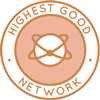 One Community is developing highest good eco-cooperative solutions through open source Highest Good Network® software that is a web-based application for collaboration, time tracking, and objective data collection. The purpose of the Highest Good Network is to provide software for internal operations and external cooperation. It is being designed for global use in support of the different countries and communities replicating the One Community sustainable village models and related components.
One Community is developing highest good eco-cooperative solutions through open source Highest Good Network® software that is a web-based application for collaboration, time tracking, and objective data collection. The purpose of the Highest Good Network is to provide software for internal operations and external cooperation. It is being designed for global use in support of the different countries and communities replicating the One Community sustainable village models and related components.
- Learn about our open source community collaboration and management software: The Highest Good Network
This week, the core team continued their work on the Highest Good Network PRs testing, confirming the fixed PRs and resolving several issues. The Fixed PRs include the Tasks “Active” column filter (PR#2712), the addition of invisibility indicators for people in their Teams page view (PR2702), the scrollbar issue on the Team Management page (PR2492), and the disablement of Edit and Delete buttons for badges based on permissions (PR2544). They also confirmed the fix for users without the ‘Create New Badge’ permission still being able to create badges (PR2771), the ability to edit end and start dates (FE#2655 + BE#1092), and preventing non-Owner/Admin users from editing the team code (PR2686). Issues that were not fixed included the requirement for a related link when submitting a review task (PR2703, 2787), improving the User Management page search function to include spaces (PR2197), email validation failure and success message location (PR2559), and the reset password function (PR#1108). Additionally, they logged 3 hours of tangible time for Week 3 of “CoreTeam TesterAgain” to test PR958 and provided Week 2 results. They also created a record to fix the issue for non-Owner/Admin accounts with the ‘Edit Team 4-Digit Codes’ permission. They also reported a bug related to the Timelog display on the viewer’s Dashboard after viewing another user’s Timelog. We continue to focus on developing highest good eco-cooperative solutions through iterative improvements and user-centric solutions. See the Highest Good Society and Highest Good Network pages for more on how this relates to developing highest good eco-cooperative solutions. The collage below shows some of their work.
ALPHA SOFTWARE DEVELOPMENT TEAM
The Alpha Team’s summary, covering their work on the Highest Good Network software software was managed by Lin Khant Htel (Frontend Software Developer) and includes Anand Seshadri (Software Engineer), and Carlos Gomez (Full-Stack Software Developer). The Highest Good Network software is how we will manage and measure our processes for developing highest good eco-cooperative solutions across our social architecture, construction, production, and maintenance processes. This week, Lin reviewed and approved PR #2799, familiarizing himself with the codebase and running tests on his local machine, where all 11 test cases passed. He also reviewed the weekly summaries, photos, and videos submitted by his Alpha team members. Carlos worked on enhancing the team hours visualization report page based on Jae’s request, focusing on improving the user interface for better display of team member data. He implemented conditional code to show a “No data” pie chart when there are no active members, centered and aligned selected members within the chart, and started developing a feature that allows users to toggle between viewing all member tags or only a single member’s tag. Anand worked on updating the issue thread of PR 2335 in the project documentation, linking an unresolved issue to a new developer. He also added test cases for the User Profile test class, including tests to verify the opening and closing of the user details modal, validation of the First Name field, validation of the email field with incorrect input, and checking password mismatch error messages in the password change fields. See the Highest Good Society and Highest Good Network pages for more on how this relates to developing highest good eco-cooperative solutions. View some of the team’s work in the collage below.
BINARY BRIGADE SOFTWARE DEVELOPMENT TEAM
The Binary Brigade Team’s summary overseeing advancements in the Highest Good Network software was managed by Vijay Anand Pandian (Full Stack Software Engineer) and includes Aaryaneil Nimbalkar (Software Developer), Abhinav Ankur (Software Engineer), Aditya Sure (Software Engineer), Anirudh Sampath Kumar (Software Developer), Ashay Kalpesh Mehta (Software Engineer), Ashmita Pandey (Software Engineer), Deepthi Kannan (Software Engineer), Huijie Liu (Software Engineer), Sandhya Adavikolanu (Software Developer), Xiaolu Li (Software Engineer) and Ziyu Chu (Volunteer Software Engineer). The Highest Good Network software is how we’ll be managing and objectively measuring our process for highest good eco-cooperative solutions through our social architecture, construction, production, and maintenance processes.
This week, Aaryaneil worked on moving the development site for Surge to a new domain, surgedev.highestgood.com. This involved editing the CircleCI deployment script and deploying the application to the new domain. He also encountered an SSL certificate issue, as Surge does not support custom domain certificates, and is working to resolve it. Additionally, Aaryaneil researched the feasibility of merging serve-static and axios versions in the HGNRest and HGN Frontend projects, testing the impact of these upgrades on the dependency trees. Abhinav developed the initial versions of all assigned pages, basing his work on the Phase 2 wireframes. He focused on accurately replicating the layout, structure, and key elements across each page, ensuring they aligned with the provided wireframes and supported the goals of highest good eco-cooperative solutions. His work laid the groundwork for future development and enhancements while prioritizing best practices for user experience and usability. Aditya focused on various tasks for the Highest Good Network project, contributing to multiple pull requests and creating new ones. He resolved issues, finalized a pull request, and moved older pull requests to new repositories. Additionally, he created new branches to address the task deadline notification and bell notification features, all in line with highest good eco-cooperative solutions. Anirudh worked on a bug in HGN Phase 2 related to the Purchase Request: Materials page, where form submissions with a 0 quantity showed an internal server error instead of the correct error message. He tested the form to ensure proper error handling. Anirudh also addressed a bug in HGN Phase 1 involving start and end dates when adding or editing tasks on the project page. He confirmed that the issue with the start date did not occur when adding tasks, but the error message in edit mode was flawed. He fixed part of the formatting issue, but further work is ongoing.
Ashay worked on the “Sort Inventory” button to enable sorting based on the last modified date. He implemented sorting functionality for project name changes, but discovered that modified project names were not updating instantly, causing a delay in visibility. He plans to adjust the method used for name modification to resolve the issue. Additionally, Ashay found that categories were changed to “unspecified” and began investigating the cause of this alteration. Ashmita worked on improving the code quality within the src/components/SetupProfile/ and src/components/common/ directories of the HighestGoodNetworkApp. Using ESLint and code formatting tools, she modified several components to enhance maintainability and consistency across the codebase, focusing on key files related to setup profiles and common components, all contributing to highest good eco-cooperative solutions. Deepthi worked on PR 2416, focusing on testing and implementing UI changes for the teams overview file. She also reviewed feedback on several existing front-end pull requests, collaborated with reviewers to gather input, and continued efforts to get the PRs merged into the development branch. Huijie focused on developing the meeting scheduling feature and the bell notification functionality. She ensured that the page permissions were correctly configured for different user roles, allowing proper access control. Additionally, Huijie implemented both the create and read operations for meetings, ensuring smooth functionality for scheduling and managing meetings, all in pursuit of highest good eco-cooperative solutions.
Sandhya worked on setting up and developing features for the HGN Software Development project. She cloned the frontend (HighestGoodNetworkApp) and backend (HGNRest) repositories from GitHub, switched to the development branches, and configured her environment by installing Node.js v14.21.3 and npm 6.x using nvm for version management. Sandhya installed dependencies for both repositories, created .env files with necessary configurations, and adjusted settings as required. She developed the TaskCompletedBarChart feature, ensuring proper interaction between frontend and backend, committed her changes, and submitted a detailed Pull Request, while also addressing issues and engaging with the team on Slack. By contributing to this project, Sandhya is helping to create the highest good eco-cooperative solutions that benefit the community. Vijay worked on several tasks related to HGN Software Development. He reviewed pull requests, including unit test code refactoring that added test files to the appropriate folders (PR #2783), unit tests for the ToggleSwitch component to ensure functionality across various switch types (PR #2761), and improvements to the checkbox in the badge development component (PR #2765). Vijay also addressed a badge management component route issue by implementing Redux state management to preserve the active tab’s state, even after a page reload (PR #2800). Additionally, he reviewed PRs related to deleting and adding teams in the profile page’s Teams tab (PR #2806) and a fix for the one-day discrepancy in start dates between the user management and reports pages for accounts without logged time (PR #2798). Xiaolu continued addressing a UI issue in Firefox related to the Timer component, where extra up and down arrows appeared next to the time numbers under the Initial Goal section. After discussing with the manager and researching potential solutions, Xiaolu modified the Countdown.module.css code to correct the issue in Firefox without affecting Chrome. Their collaborative efforts contribute to the highest good eco-cooperative solutions by enhancing the user experience and ensuring functionality across different platforms. A pull request has been created and is awaiting review. Ziyu began working on unit test tasks for the QuickSetupModal/QuickSetupModal.jsx component. She set up the initial framework, including importing necessary modules, mocking dependencies, and initiating the test process. Ziyu also outlined five test cases to evaluate the component’s functionality and hooks, with plans to complete the specific code for these tests in the coming days. See the Highest Good Society and Highest Good Network pages for more on how this relates to highest good eco-cooperative solutions. View some of the team’s work in the collage below.
BLUE STEEL SOFTWARE DEVELOPMENT TEAM
The Blue Steel Team’s summary, presenting their work on the Highest Good Network software was managed by Jingyi Jia (Software Engineer, Team Manager), and includes Cillian Ren (Software Engineer) and Ramakrishna Aruva (Software Engineer). The Highest Good Network software is how we’ll be managing and objectively measuring our process for developing highest good eco-cooperative solutions through our social architecture, construction, production, and maintenance processes. This week, Ramakrishna completed the conversion of the weekly summary class components into functional components but encountered failing unit tests. He spent the week troubleshooting these issues, experimenting with various approaches in search of a solution. Cillian focused on resolving a white screen problem that occurred when deleting a task in the Highest Good Network project, part of the highest good eco-cooperative solutions initiative. He inspected the code to identify the cause and made necessary corrections to ensure that the interface functioned correctly post-deletion. Cillian also completed tests across different task deletion scenarios and adjusted the functionality based on team feedback to enhance user experience. Meanwhile, Jingyi reviewed five pull requests: PR#2798, PR#2794, PR#2796, PR#2782, and PR#2736. She resolved merge conflicts with the development branch and initiated a new pull request to address the ongoing issue of the loading icon persisting when adding new projects, thereby improving the responsiveness and efficiency of the user interface. See the Highest Good Society and the Highest Good Network pages to learn more on how their work contributes to developing highest good eco-cooperative solutions. See below to view images of their work.
CODE CRAFTERS SOFTWARE DEVELOPMENT TEAM
The Code Crafters Team’s summary, covering their work on the Highest Good Network software, was managed by Akilan Kumaran (Software Engineer) and includes Ambika Kabra (Software Engineer), Dhrumil Dhimantkumar Shah (Software Engineer), Pavan Swaroop Lebakula (Software Engineer), Summit Kaushal (Backend Software Developer), Swaroop Udgaonkar (Software Engineer), Muzammil Moahmmed (Software Engineer) and Denish Kalariya (Software Engineer). The Highest Good Network software is how we’ll manage and objectively measure our process for developing highest good eco-cooperative solutions through our social architecture, construction, production, and maintenance processes. This week, Ambika created pull request 2796 in the frontend repository and investigated an issue in the Add/Update Task modal where the Start Date appeared later than the End Date when only the End Date was updated. This required reviewing previous pull requests and examining task database entries. She also addressed a cropping issue in the Reports > Team calendar and submitted the pull request for review. During debugging, Ambika identified that team members were not appearing in the table due to code being commented out in a previous pull request. She also reviewed the calendar pages to assess the impact of the cropping issue. Denish focused on documenting issues and bugs related to graphical report representations for the Weekly Volunteer Summary and led a team meeting to analyze the challenges and assign tasks for resolution, all contributing to highest good eco-cooperative solutions. Additionally, Denish worked on resolving an inconsistency between the frontend and backend hour ranges, aligning them for optimal system performance. Dhrumil submitted a pull request for the teams module and began work on Bug 124, ensuring the “Export Featured” button is disabled when no badges are featured, seeking clarification on the issue from Jae. Summit worked on a badge update issue caused by caching, adjusting the created date to ensure proper badge assignment for milestones and addressing a TypeError in the backend that was preventing badge awards. Pavan worked on improving the task editing interface to reduce vertical space and addressed button alignment issues, as well as fixing a navigation issue with the ‘Timelog’ and Bell icons. Through these efforts, the team is committed to developing the highest good eco-cooperative solutions, enhancing overall functionality and user experience. Muzammil worked on resolving a color inconsistency in a pie chart when navigating between the Dashboard and Reports pages, investigating the root cause by reviewing previous pull requests. Swaroop worked on optimizing the alignment of projects, teams, and reports for smaller screens, reviewed a previously merged pull request, and assisted Geeta, a volunteer, with setting up her local environment for the HGN project, while also reviewing team summaries, photos, and videos as part of his Manager in Training role. See the Highest Good Society and Highest Good Network pages for more on how this relates to developing highest good eco-cooperative solutions. The collage below shows the work for this week.
DEV DYNASTY SOFTWARE DEVELOPMENT TEAM
The Dev Dynasty Team’s summary, covering their work on the Highest Good Network software, was managed by Harsh Bodgal (Software Engineer) and includes Ajay Kumar Reddy (Software Engineer), Crystal Low (Software Engineer), Howie Miao (Software Engineer), Jatin Agrawal (Software Engineer), Manikrishna Sanganabatla (Software Engineer), Mrinalini Raghavendran (Software Engineer), Nandini Yelmela (Software Engineer), Sailavanya Narthu (Software Engineer), Shreya Vithala (Software Engineer), Nikita Kolla (Full Stack Developer) and Nishita Gudiniye (Software Engineer). The Highest Good Network software is how we’ll manage and objectively measure our process for developing highest good eco-cooperative solutions through our social architecture, construction, production, and maintenance processes. This week, Harsh analyzed API changes and prepared a document to track these updates. He also updated the document that tracks frontend feature development. Additionally, Harsh held a meeting to explain tasks and recent changes to the team and coordinated with team members to clarify design changes. He tested the updates to the Total Hours Worked chart and addressed a text display issue related to the generate PDF button. Ajay focused on resolving a date mismatch issue between the user management and reports pages, identifying that inconsistent date handling in the frontend caused the problem. He implemented UTC formatting with moment.js to correct it and developed Python scripts to verify the fix. Mrinalini worked on debugging a timer reset issue during page reloads and refined mockups based on feedback from Jae, updating a Google document with new design changes. Nishita completed the “Help finish Lint fixing” task, resolving an ESLint configuration issue, and began working on backend tasks involving Team Stats. These efforts contribute to highest good eco-cooperative solutions, ensuring effective collaboration and development across the team. Howie addressed hotfixes, including adjusting the teams scrollbar and updating the task submission link with a double confirmation process. Sailavanya made progress in resolving a blank page issue, resolving most conflicts, though one remains, which she continues to address. Crystal worked on ensuring deactivated users no longer appear in the Weekly Summaries Reports, clarifying the interpretation of the “endDate” to filter users correctly. These efforts contribute to the highest good eco-cooperative solutions by enhancing overall system functionality and user experience. Manikrishna reviewed multiple pull requests, addressing merge conflicts, and researched options for implementing a share PDF button. Shreya deleted a duplicated leaderboard test file, added new test cases, and began a new task related to processing additional core team hours, creating new branches for frontend and backend code changes. Nikita developed React components for the Google Forms replacement task, integrating Redux and completing the required functionality, and began focusing on styling the components. Jatin worked on creating a backend for a custom form similar to Google Forms. He developed the necessary models, routes, and controllers for the form. He also began testing the functionality to ensure it stores data and provides the expected results. In addition, Jatin reviewed the implementation to identify potential improvements in the workflow. See the Highest Good Society and Highest Good Network pages for more on how this relates to developing highest good eco-cooperative solutions. View some of the team’s work in the collage below.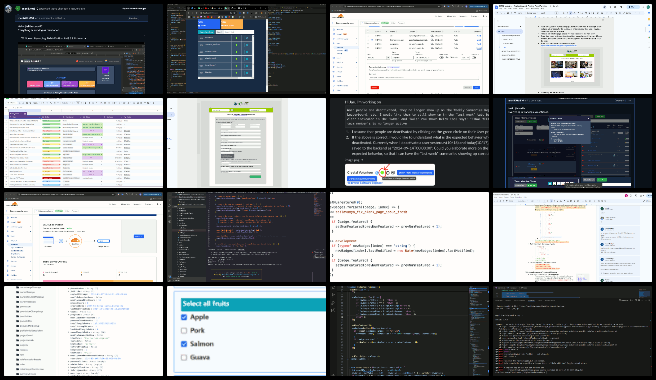
EXPRESSERS SOFTWARE DEVELOPMENT TEAM
The Expressers Team’s summary, covering their work on the Highest Good Network software, was managed by Christy Guo (Software Engineer) and includes Faye Lyu (Software Engineer), Rahul Trivedi (Software Developer), Reina Takahara (Software Developer), and Strallia Chao (Software Engineer). The Highest Good Network software is how we’ll manage and objectively measure our process for developing highest good eco-cooperative solutions through our social architecture, construction, production, and maintenance processes. This week, Christy worked on a project task chart visualization using D3.js, integrating sorting and filtering features to display tasks based on their completion status, hours, and remaining hours. Faye continued debugging the SummaryBar component in HGN Software Development, focusing on fixing bugs and improving its functionality. Rahul improved the responsiveness of the Reports Team Member page and tested it in both light and dark modes. Reina applied feedback to ensure correct project names, adjusted navigation, and worked on displaying tags for lesson submissions. Strallia updated PR#2767 by adding dark mode, custom tooltips, and responsiveness to the line chart. See the Highest Good Society and Highest Good Network pages for more on how this relates to developing highest good eco-cooperative solutions. See the collage below to view the team’s work this week.
LUCKY STAR SOFTWARE DEVELOPMENT TEAM
The Lucky Star Team’s summary, covering their work on the Highest Good Network software, was managed by Anne Zhang (Software Engineer) includes contributions from Chetan Sunku (Software Engineer), Gaurav Setty (Software Engineer), Shefali Mittal (Volunteer Software Engineer), Yashwanth Pokala (Software Engineer) and Ziyan Wang (Software Engineer). The Highest Good Network software is how we’ll manage and objectively measure our process for developing highest good eco-cooperative solutions through our social architecture, construction, production, and maintenance processes. This week, Anne focused on resolving conflicts in previous pull requests, fixing UI issues, and merging functions that overlapped with a teammate’s work. She also managed the Lucky Star team and reviewed photos, videos, and summaries submitted by members. Chetan created a hotfix branch to address an issue from the previous week and resumed work on dashboard time updates, where logged time is not reflected without a page reload, and is continuing to investigate the problem. Gaurav refined the Quick Setup Tool by optimizing APIs, ensuring automatic updates with the removal of the “Save Changes” button, and testing for functionality and edge cases. Shefali developed unit tests for the UserProfileEdit/UserProfileEdit.jsx component, debugging errors encountered during testing, with additional work needed to resolve failing test cases. Yashwanth completed work on the task “Make permissions changes to an individual show up in the tracking below,” presented the changes to Jae, and incorporated feedback, with additional hours allocated for further modifications. All these efforts contribute to highest good eco-cooperative solutions. He also made progress on fixing the Category column on the Projects page by writing a controller class, creating a MongoDB model for permission-related logs, updating routes, and implementing the UI. Ziyan began work on the “146 Optimize the app for Safari” task, reviewing compatibility issues but encountering build errors, including a “module not found” issue and dependency conflicts, which are still under investigation. Additionally, Ziyan uploaded images to the Week 3 folder. See the Highest Good Society and Highest Good Network pages for more on how this relates to developing highest good eco-cooperative solutions. See the collage below to view the team’s work this week.
MOONFALL SOFTWARE DEVELOPMENT TEAM
The Moonfall Team’s summary, covering their work on the Highest Good Network software was managed by Lu Wang (Team Manager), and includes Calvin Liu (PR Team), Nikhil Giri (Software Engineer), Rishabh Nevatia (Software Engineer), Saurabh Shetty (Software Engineer), Satya Shanthi Tadiparthi (Software Engineer), Swathi Dharma Sankaran (Software Engineer), Vedant Gandhi (Software Engineer), and Yili Sun (Software Engineer). The Highest Good Network software is how we’ll manage and objectively measure our process for developing highest good eco-cooperative solutions through our social architecture, construction, production, and maintenance processes. This week, Calvin worked on PR 2786 to address Bug 16 in the Inventory Type List by adding a scrollable feature to limit table height. He has alternated row colors for readability and a hover effect for improved feedback. He has enhanced table styling and resolved an issue with inline background styles that was overriding the global hover effect by moving the alternating row colors to the CSS file, improving both user interaction and maintainability. Lu has focused on managing her team and trained assistant manager Satya in team management processes. She has reviewed his progress, and completed unit testing tasks. Additionally, she has ensured all tests were passed and comments were added. Nikhil worked on developing an auto-poster for Facebook and Facebook Groups to replace the service provided by OnlyWire. He has reviewed several pull requests, and ensured consistency in start dates across reports, user management pages, and proper date picker visibility in both normal and dark modes, all while contributing to highest good eco-cooperative solutions. Rishabh has focused on phase 2 of the application and resolved discussions with teammates, all while aligning their efforts with highest good eco-cooperative solutions. He has started the first part of a task related to access restrictions for owner users, and addressed encountered errors. Saurabh has addressed a login form UI issue. He has verified and closed the task for phase 2, and began working on logging time for tasks. Also, he has identified that the hour count updated correctly for the current week and leaderboard but not for the team member’s task progress. Satya worked on PR reviews and unit test verifications, including the Login component, DeleteBadgePopup, LeaderBoard component tests, Teams component API calls, and unit tests for ColorsGenerator and PeopleReport selectors. Additionally, she has contributed to a UI layout fix for mobile and tablet views. She has balanced technical work with team management tasks and reviewed team members’ progress reports. Swathi has enhanced the task management interface and raised PR 2789 to align the task display for resources. Together, these efforts contribute to the development of highest good eco-cooperative solutions, ensuring that our project aligns with sustainable and community-focused goals. She has refined the filtering logic for paused tasks, and tested the changes across various scenarios for consistency. Vedant has continued work on phase 2 bugs and improved the table design, scrollable region visibility. He has explored multi-select options for project display while resolving a failing test from a previous pull request. Yili has fixed a page freezing issue in the Reports section when clicking on active green or grey dots and addressed the unit test for PR 2785, which dealt with the Assign/Edit/Delete Blue Squares Permission functionality. See the Highest Good Society and Highest Good Network pages for more on how this relates to developing highest good eco-cooperative solutions. Below is a collage for the team’s work:
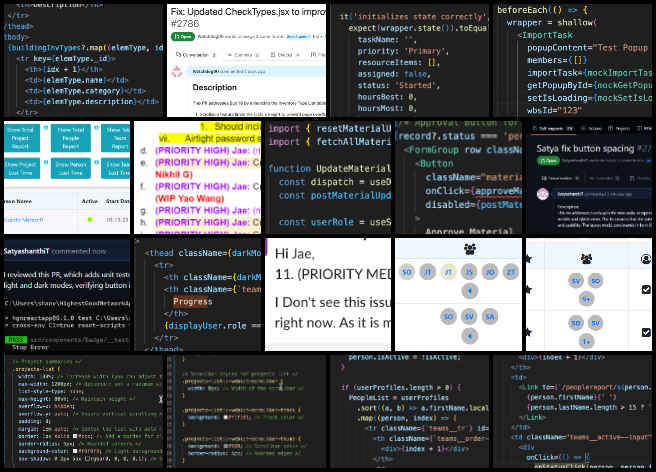
REACTONAUTS SOFTWARE DEVELOPMENT TEAM
The Reactonauts Team’s summary, covering their work on the Highest Good Network software, was managed by Vijeth Venkatesha (Software Engineer). It included Dhairya Mehta (Software Engineer), Gmon Kuzhiyanikkal (Software Engineer), Haoyue Wen (Software Engineer), Jinxiong You (Software Developer), Khushi Jain (Software Engineer), Mohan Gadde (Software Engineer), Nikhil Pittala (Software Engineer), Peterson Rodrigues dos Santos (Full-Stack MERN Stack Developer), Rishitha Mamidala (Software Engineer) and Saniya Farheen (Software Engineer). The Highest Good Network software is highest good eco-cooperative solutions across social architecture, construction, production, and maintenance processes.
This week, Dhairya focused on addressing the “Fix Projects find user function” task with dedicated effort, showcasing adept problem-solving skills. Through meticulous analysis, he accurately identified the root cause of the issue affecting user discovery within the projects section. Leveraging this understanding, Dhairya took proactive steps to develop a comprehensive sort and search function. This strategic initiative is aimed at optimizing user assignment processes within the project section, thereby improving operational efficiency and enhancing the overall user experience. By implementing these improvements, Dhairya is contributing to the highest good eco-cooperative solutions, promoting sustainability and collaboration in our projects.
Gmon worked on his new task on adding active/inactive numbers by teams on the team page, and a new pull request branch has been created, and it is called Gmon-Active-NonActive-team. He has also completed his bio for publishing on the main page too. However, he is facing an issue while running the code, and the code base is crashing when it is running locally. Gmon is trying to fix the error in the code as of now. All the relevant screenshots and video to highlight specific issues are added. Additionally, he spent time understanding the project’s architecture and existing features, ensuring they were well-prepared for upcoming tasks and contributions, focusing on the highest good eco-cooperative solutions.
Haoyue resolved several merge conflicts and made improvements to existing code by addressing issues and refining imperfections based on reviewer feedback. Additionally, she initiated work on the new FAQ feature, beginning the research and planning phase to ensure a smooth implementation that will enhance user support within the application. Jinxiong worked on identifying and addressing bugs in the HGN Apps, with a focus on improving functionality and performance. He concentrated on resolving a layout change issue with the header and identified the source of the problem in the CSS file. After addressing the issue, the layout was corrected. He plans to publish the Pull Request on GitHub on Saturday.
Khushi worked on creating a mockup design for the “New Position Setup Page.” She reviewed the project requirements and began her research to develop a draft design for the page, which allows the Owner to create application options that will appear on the app’s Application Page. The mockup includes fixed fields that are mandatory for all applicants, along with customizable fields that the Owner can edit or add to tailor the application to specific positions. Using elements from the existing Collaboration Page as a reference, she designed fields and layout components. Additionally, Khushi incorporated a feature for a general questionnaire that can be tailored to the applicant’s title or profession, aligning with highest good eco-cooperative solutions to ensure sustainability and community focus in the hiring process. She also added an “Ads Link” feature, allowing users to access a direct link to an ad when available, or alternatively, to link to multiple general pages if no specific ad link is provided. To visualize interactive elements within the mockup, she created placeholders for icons, buttons, toggles, and dropdowns to indicate user interaction points. Currently, the mockup includes sections for the Header, Fixed Fields, General Questionnaire, Customizable Fields, Ads Link, and Review & Save, with plans to continue developing additional sections that contribute to the highest good eco-cooperative solutions. Nikhil completed 12 PR reviews, focusing on front-end, back-end, and unit testing tasks. The reviews involved evaluating code changes for functionality, consistency, and adherence to project standards. In addition to identifying potential issues, Nikhil collaborated with team members to provide feedback and ensure smooth integration of updates. These tasks required attention to both the technical aspects of the code and the overall workflow to maintain the project’s stability and progress.PR #2799, PR #2798, PR #2796, PR #2795, PR #2794, PR #2792, PR #2782, PR #2783, PR #2790, PR #2788, PR #2789, and PR #2786.
Mohan focused on optimizing the team management process within the Profile section. He worked on improving the “Delete Team” and “Assign Team” functions, which currently require a manual save between actions. The goal was to implement an auto-save feature when deleting or adding a team to streamline the process and enhance efficiency. Peterson enhanced the 404 error page, which is displayed when a user attempts to access a non-existent page. The improvements included adding an image to the page and updating the displayed message. Additionally, the colors of the image, text, and app background now automatically adjust to the theme selected by the user, whether dark or light.
Rishitha focused on lint fixing within the user management folder, identifying and resolving code style issues to improve consistency and maintainability. She completed code refactoring for 18 files, optimizing the structure and readability of the codebase. The changes included removing unused imports, updating outdated syntax, and improving function clarity without altering functionality. There are five remaining files that require refactoring, which will be addressed in the following week to finalize the updates to this portion of the project, contributing to highest good eco-cooperative solutions initiative.
Saniya addressed a bug related to the dashboard, specifically modifying the prompt that appears when clicking the red or green circle next to a person’s name. She made changes to adjust the behavior of the prompt triggered by this action. Additionally, she was able to access a person’s tasks as demonstrated in a video from Jae. In a separate task, she accessed a team member’s tasks and documented the results through a screen recording. She is currently reviewing and testing to verify if the bug is resolved and plans to proceed with pull requests once confirmation is achieved, contributing to highest good eco-cooperative solutions.
Vijeth Venkatesha focused primarily on team management, spending time understanding the team management process and communicating with team members to address their queries. He also organized and hosted the weekly team meeting to gather updates from each member. See the Highest Good Society and Highest Good Network pages for more information on how this relates to highest good eco-cooperative solutions. See the collage below for the team’s work this week.
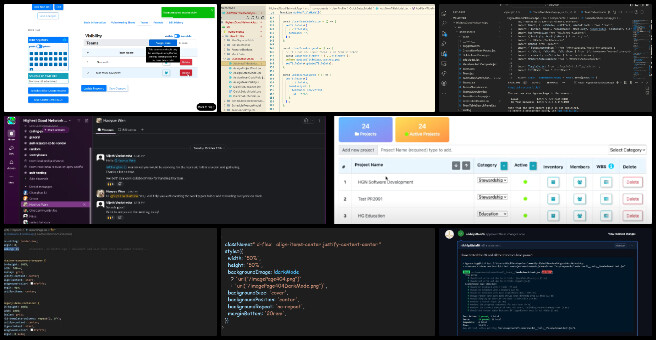
SKYE SOFTWARE DEVELOPMENT TEAM
The Skye Team’s summary covering their work on the Highest Good Network software was managed by Deepthi Arcot Subramanyam (Data Analyst) and Luis Arevalo (Software Engineer) and the team includes Angela Cheng (Full Stack Developer), Abi Liu (Software Developer), Laura Cohen (Software Engineer), Sai Preetham Dongari (Full Stack Developer), Snehal Dilip Patare (Software Engineer) and Yao Wang (Software Engineer). The Highest Good Network software supports highest good eco-cooperative solutions, social architecture, construction, production, and maintenance processes. This week, Luis began laying the groundwork for creating new warnings based on Jae’s feedback. He encountered issues with the front end crashing and created a new branch, facing challenges with integrating the new code. After working through the problems, he integrated his previous code into the new branch. He started creating the modal and made the necessary adjustments. He also documented notes for the upcoming tasks, including adjusting the button’s distance and ensuring that when a button is selected, a modal appears, similar to issuing warnings after two have been given. Abi researched strategies for embedding graphs into emails, participated in a group meeting to discuss back-end API development, and assisted Denish in understanding API requirements. He also worked on refactoring the volunteer trends method by creating its own route and fixing the query, contributing to highest good eco-cooperative solutions. Laura reviewed front-end and back-end code in the HighestGoodNetworkApp and HGNRest to aid the implementation of the permission change modal. She added code to the modal and made adjustments through trial and error to determine the correct placement for integrating it into the application. Angela focused on creating a replacement service for the HGN Software Development project, debugging Twitter OAuth 2.0 methods, and ensuring support for both base64 and URL image types for Twitter and Pinterest. She discussed API sources with a colleague and reviewed the Onlywire API to decide between using it or building a solution. She researched JavaScript scheduling options, specifically the node-schedule and agenda packages, and explored MongoDB integration for saving scheduled posts with the Agenda package. Yao replaced the “onlywire” feature to enable posting on LinkedIn by creating a front-end UI layout that posts to LinkedIn through APIs sourced from the LinkedIn developer page. Additionally, they focused on developing solutions for the highest good eco-cooperative solutions. Snehal created a pull request (PR#2801) to address a user ID change in the dashboard and began working on a bug related to deleting members from the projects on the member’s page. She reviewed comments on PR#2801 and made necessary changes, with plans to continue resolving the bug. Sai addressed the missing search functionality on the Team Member Page, beginning by understanding the existing code and what was required to implement the feature. He identified gaps in front-end event handling and back-end API routes, created a new GitHub branch for his work, and made code adjustments to improve the display of search results on the Team Report page. He also documented his progress with weekly summaries and Dropbox images. His contributions are part of our commitment to developing highest good eco-cooperative solutions. See below for some of the team’s work.
SOFTWARE PR REVIEW TEAM A-H
The PR Review Team’s summary for team members’ names starting with A-H and covering their work on the Highest Good Network software was managed by Anoushka Hazari (Data Analyst). The Highest Good Network software is a foundation of what we’ll be using to measure our results for developing highest good eco-cooperative solutions. This week’s active members of this team were: Abdelmounaim Lallouache (Software Developer), Anoushka (Software Engineer), Ashish Nagraju (Software Engineer), Bhavya Prakash (Software Engineer), Carl Bebli (Software Engineer), Lucy Xi (Software Engineer), and Geeta Matkar (Software Engineer). They reviewed all the Highest Good Network PRs (Pull Requests) shared in this week’s update. Learn more about how the Highest Good Network will measure and assist in developing highest good eco-cooperative solutions in the Highest Good Network open source hub. The collage below shows a compilation of the work from this team.
![]() SOFTWARE PR REVIEW TEAM I-N
SOFTWARE PR REVIEW TEAM I-N
The PR Review Team’s summary for team members’ names starting with I-N and covering their work on the Highest Good Network software was managed by Saumit Chinchkhandi (Administrative Assistant and Software Engineer). The Highest Good Network software is a foundation of what we’ll be using to measure our results of developing highest good eco-cooperative solutions. This week’s active members of this team were: Koushica Bosadi Ulaganathan (Software Engineer), Kurtis Ivey (Software Engineer), Nahiyan Ahmed (Full Stack Software Developer), Nanguan Lin (Software Engineer), Nathan Hoffman (Software Engineer), Navya Sri Ankireddy (Software Engineer), Newell Yin (Software Engineer), and Nikhitha Kalinga (Software Engineer). They reviewed all the Highest Good Network PRs (Pull Requests) shared in this week’s update. Learn more about how the Highest Good Network measures and assists in developing highest good eco-cooperative solutions in the Highest Good Network open source hub. The collage below shows a compilation of the work from this team.
SOFTWARE PR REVIEW TEAM R-Sa
The PR Review Team’s summary for team members’ names starting with R-Sa and covering their work on the Highest Good Network software was managed by Olawunmi “Ola” Ijisesan (Administrative and Management Support) and Mrudula Chavali (Administrative Assistant and Data Analyst). The Highest Good Network software is a foundation of what we’ll be using to measure our results of developing highest good eco-cooperative solutions. This week’s active members of this team were: Pallavi Thorat (Software Engineer), Rachana Rizhkant Zha (Software Development Engineer), Rashmitha Yadhav (Software Engineer), Rupa Bhatia (Software Engineer), Sharadha Shivakumar (Software Engineer), Shashank Kumar (Software Engineer), Sheetal Mangate (Software Engineer), Shengwei Peng (Software Engineer), Shreya Laheri (Software Developer). They reviewed all the Highest Good Network PRs (Pull Requests) shared in this week’s update. Learn more about how the Highest Good Network will measure and assist in developing highest good eco-cooperative solutions in the Highest Good Network open source hub. The collage below shows a compilation of the work from this team.
SOFTWARE PR REVIEW TEAM Si-Z
The PR Review Team’s summary for team members’ names starting with Si-Z and covering their work on the Highest Good Network software was managed by Olawunmi “Ola” Ijisesan (Administrative and Management Support) and Samarth Urs (Administrative Assistant and Data Analyst). The Highest Good Network software is a foundation of what we’ll be using to measure our results of highest good eco-cooperative solutions. This week’s active members of this team were: Shivansh Nathani (Software Engineer), Vaibhavi Madhav Deshpande (Software Engineer), Neeharika Koniki (Software Engineer, Developer), Yiyun Tan (Software Engineer), and Zhimin Liang (Full Stack Developer). They reviewed all the Highest Good Network PRs (Pull Requests) shared in this week’s update. Learn more about how the Highest Good Network will measure and assist in highest good eco-cooperative solutions in the Highest Good Network open source hub. The work helps One community’s mission of highest good eco-cooperative solutions and reinforces our commitment to a better living quality for all people. The collage below shows a compilation of the work from this team.
AND WE PRODUCED THIS WEEKLY UPDATES BLOG – CLICK HERE TO SUBSCRIBE
FOLLOW ONE COMMUNITY’S PROGRESS (click icons for our pages)
INVESTOR PAGES
GET INVOLVED
DONATE | WAYS ANYONE CAN HELP | MEMBERSHIP
CLICK HERE FOR ALL PAST UPDATES
 One Community
One Community